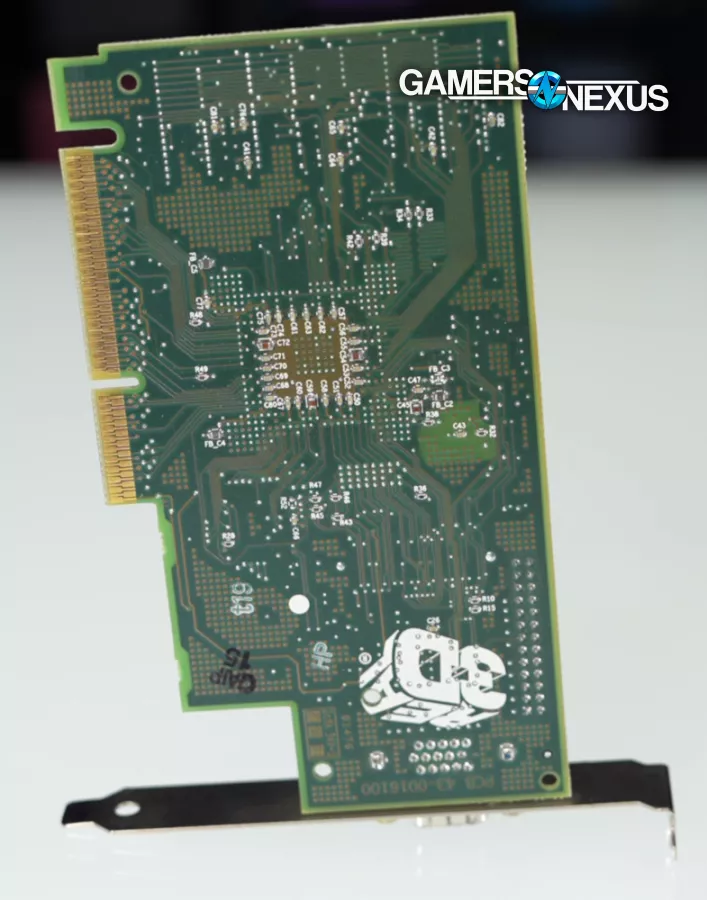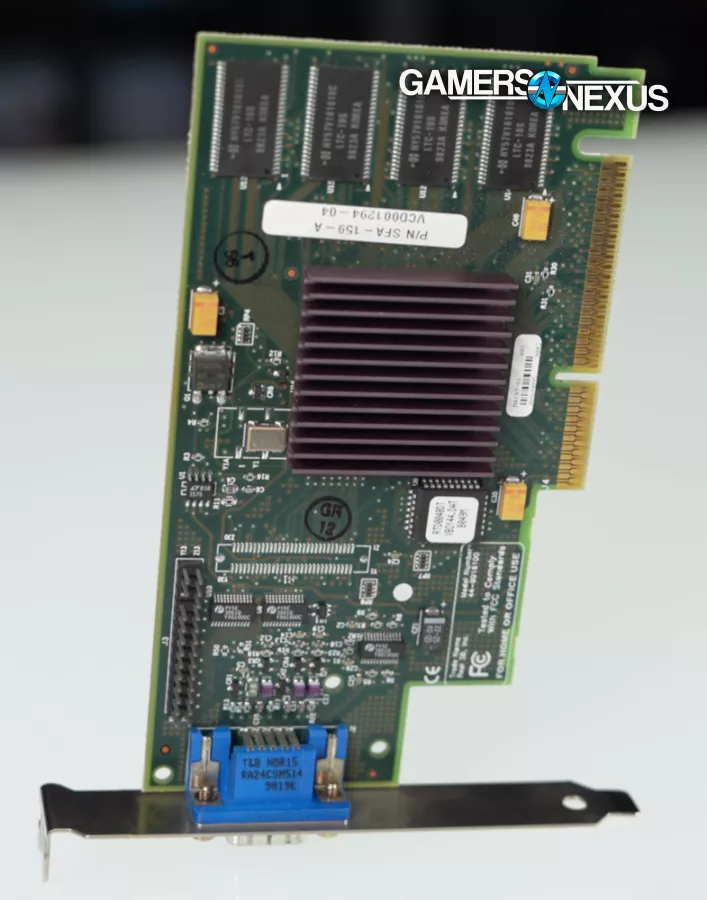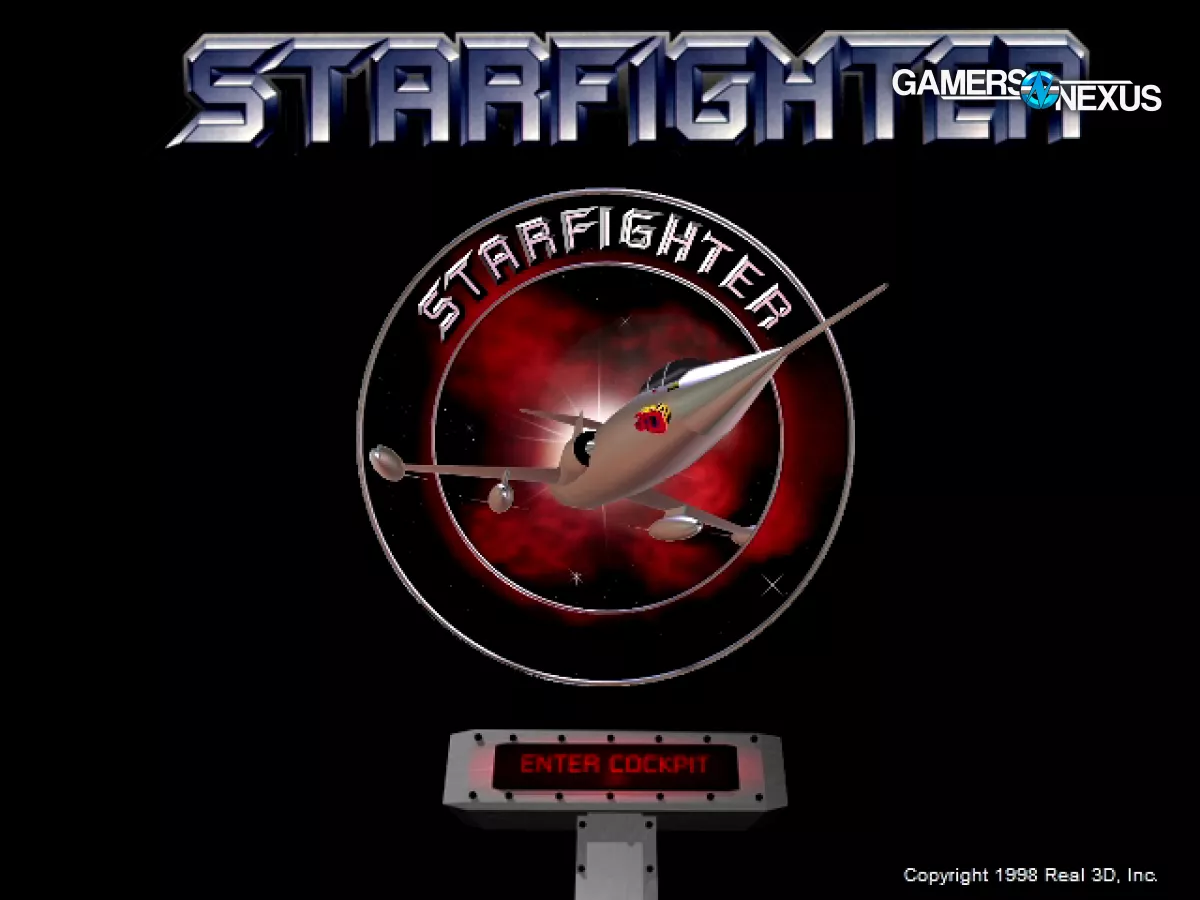
Back from the Dead: 3dfx's Unreleased Voodoo5 6000 Quad-GPU Card
December 9, 2023
Last Updated: 2023-12-09
Anthony ZXCLXIV recreates unreleased 3dfx video cards using genuine parts, including the Voodoo5 6000
The Highlights
- The "Strange God AGP" is a functional homebrew Voodoo5 6000
- New card is a warts-and-all recreation
- More than 20 years after its cancellation, we benchmark a card that was never sold
- MSRP (of Strange God): ~$1500
Table of Contents
- AutoTOC

Intro
This is an unreleased 3dfx Voodoo5 6000 GPU—or set of GPUs—built on a custom 80-Watt "Strange God" board with four 166MHz 3dfx VSA-100 "Napalm" chips in double SLI, a 66MHz AGP 1.0 interface, 6-pin PCIe power input, 16x16MiB SDR SDRAM chips for a total of ~256MB of onboard memory, and dual VBIOS (128MB or 256MB memory modes). The card was doomed when it was being made by 3dfx: it was one of their last products.
This card shouldn't exist, but we have two. There’s no such thing as a retail 3dfx Voodoo5 6000; they never made it to market. Instead, these cards were created by Anthony ZXCLXIV (ZXC-64). As a hobby, he hand-assembles and sells custom cards, including 3dfx's lost crown jewel. He designs and orders PCBs, then populates them with new old stock 3dfx chips purchased in bulk, usually taking three days to assemble each card. No one has produced a Voodoo5 6000 for over 20 years, and the last people who did never shipped it. Today, we finally get to tell you about this card that we bought from ZXC-64 for about $1500 US.
(This was originally published on our YouTube channel on April 7, 2023; however, rather than backdate this special feature piece, we're letting it publish with the current date to hit the front page of our site. No changes have been made to the content.)
Credits
Host, Supporting Writing
Steve Burke
Testing, Writing Lead, Web Editing
Patrick Lathan
Video Editing
Vitalii Makhnovets
That's a vast oversimplification of the work that's gone into this project, though. In order to make new cards, Anthony first had to get his hands on a prototype. To give you some idea of their rarity, it took three years from the card's canceled launch for Extremetech's Joel Hruska to find one and write what he called "the first full review of the Voodoo5 6000" back in 2003. With the help of a collector, Anthony was able to borrow a damaged and non-functional unit, and from there managed to non-destructively reverse engineer it and build a new card from scratch. It could have been emulated instead, something that 3dfx’s own founders acknowledged.
I have no idea [laughs]. They...yeah, it's, it's interesting. But, because they can.
Gary Tarolli, 3dfx co-founder and CTO
In an interview with CustomPC, Anthony stated that "Making the PCB wasn’t very complicated—I placed all the design blocks around the board and solved the puzzle that way—there were no other available variations." We get the feeling he's underselling himself: he's gone as far as to make multiple revisions of a card left abandoned, including extended memory, PCI interfaces, different power inputs to replace the original DC barrel jack, and VGA pass-through. This is real engineering.
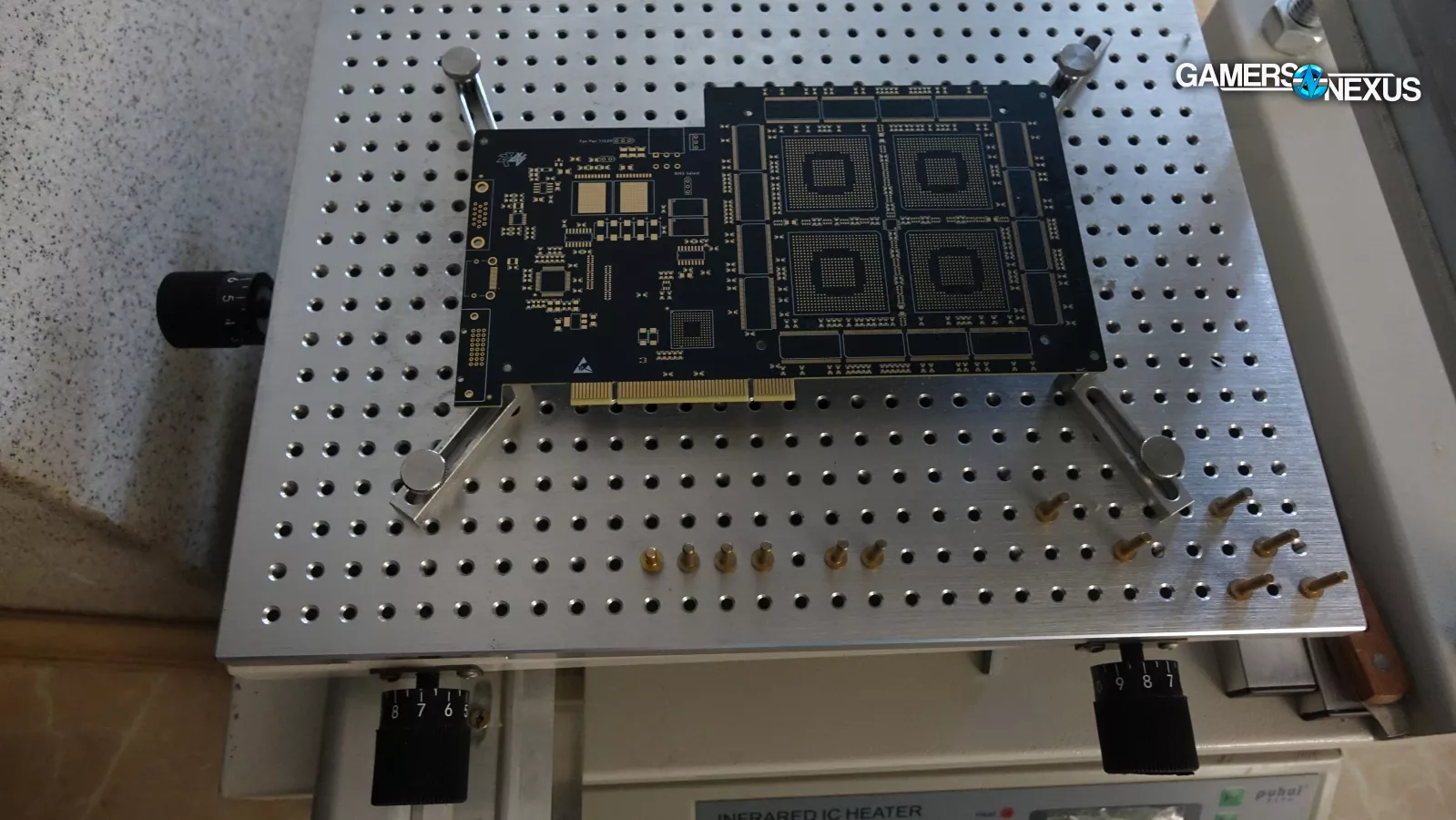
PCB on the stencil printer 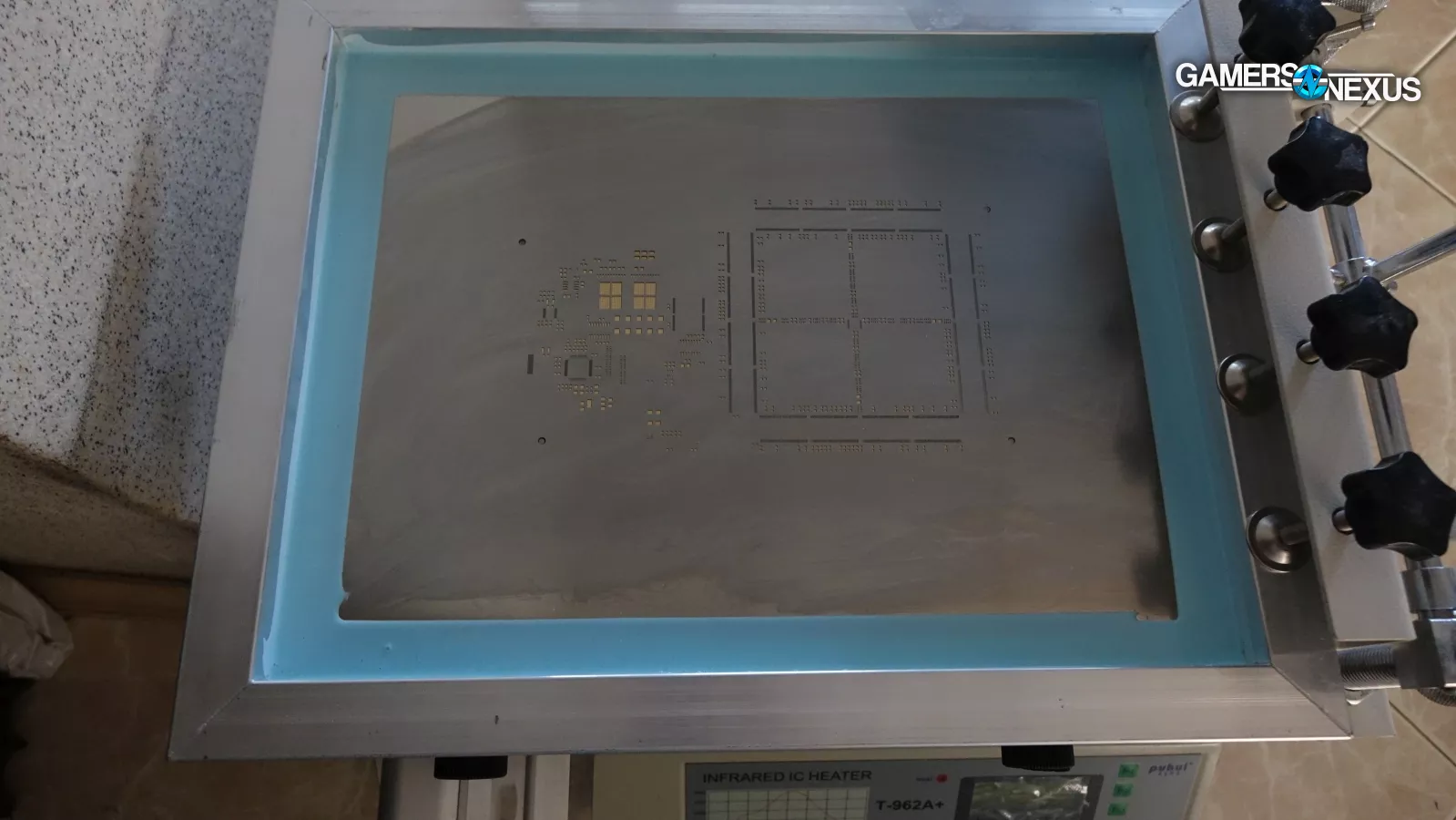
Applying solder paste 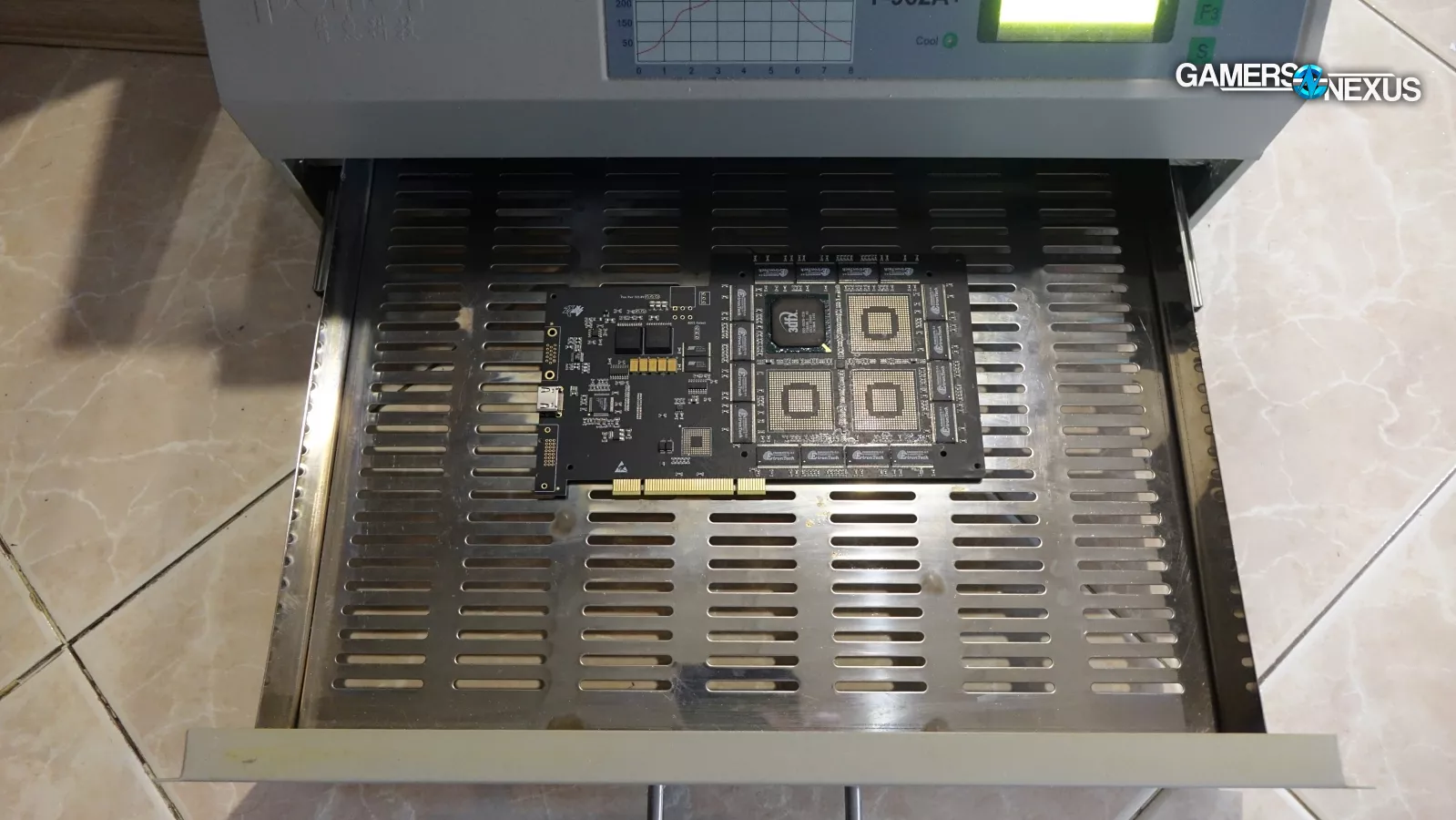
Put PCB in the solder oven 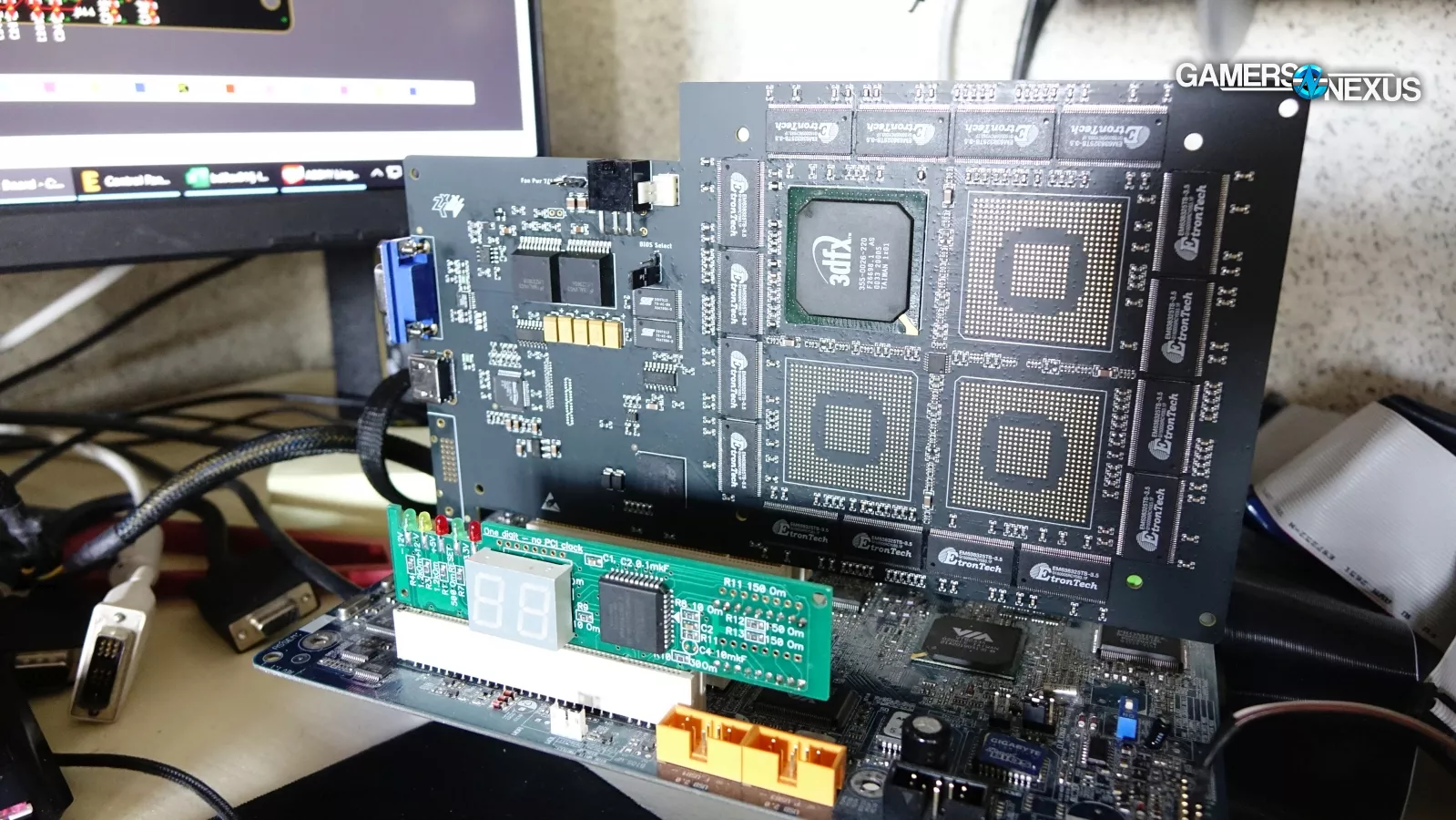
Testing PCB in single chip mode 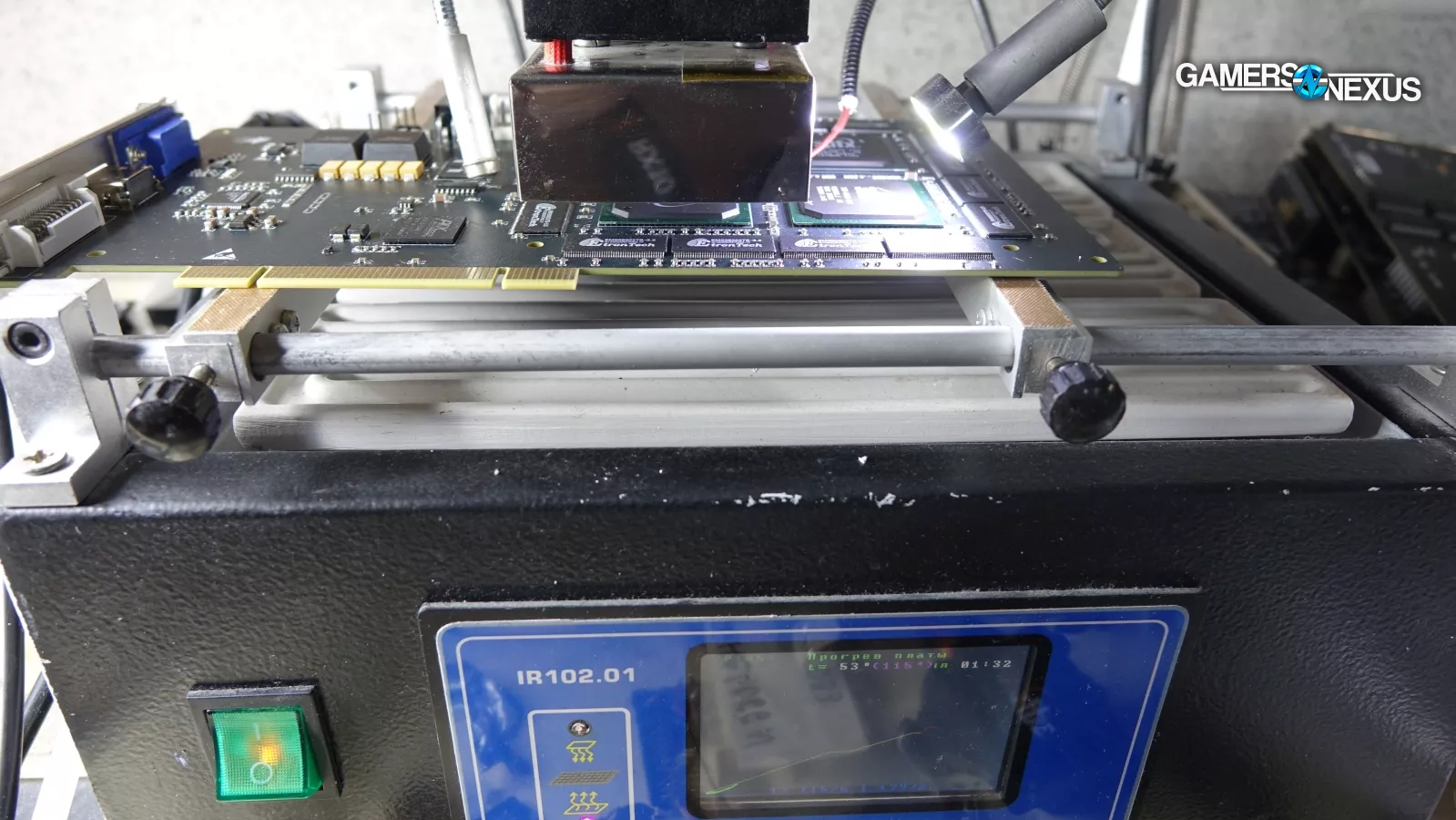
Solder the rest of the VSA chips 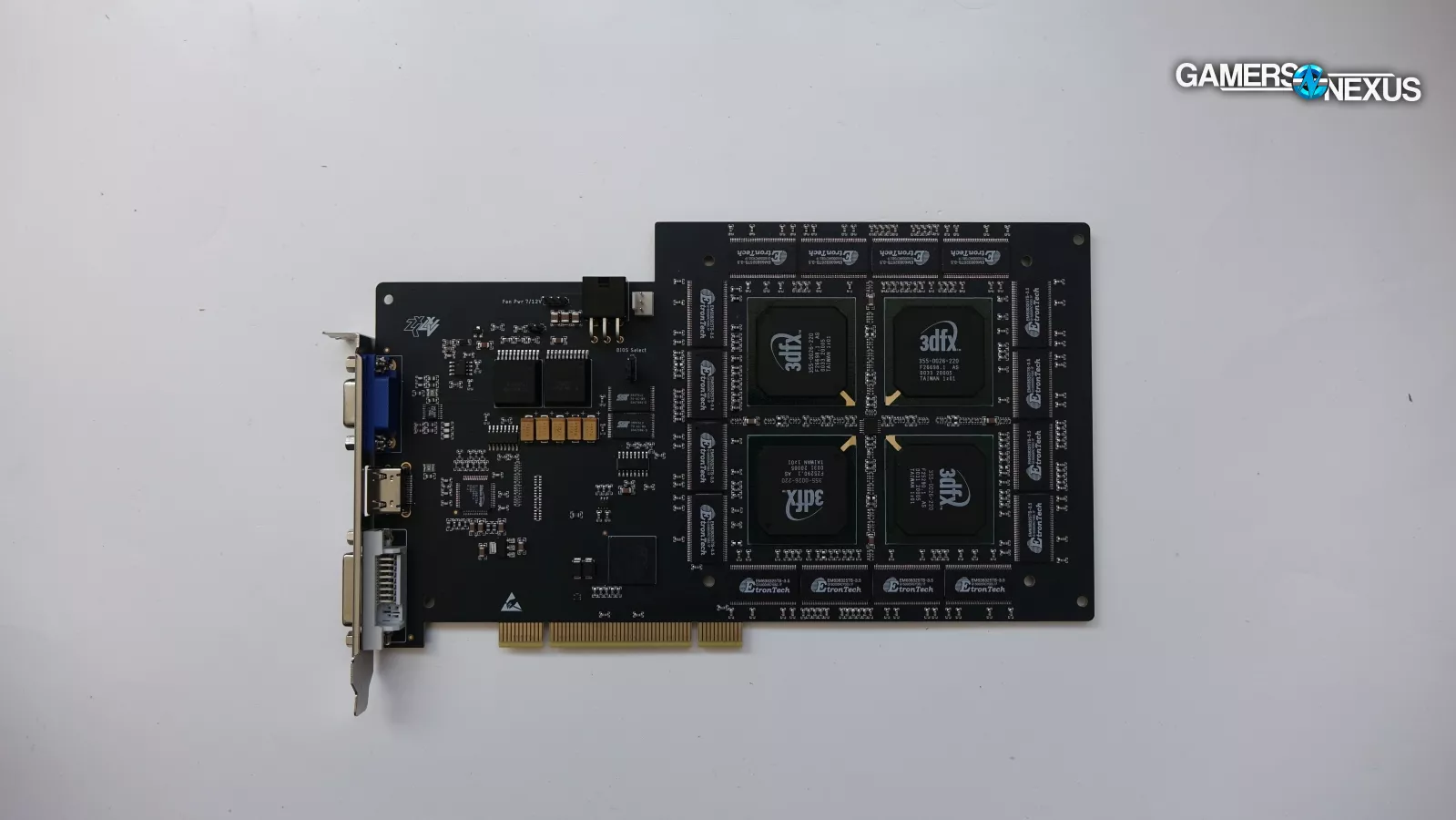
Assembled PCB
3dfx Voodoo's History
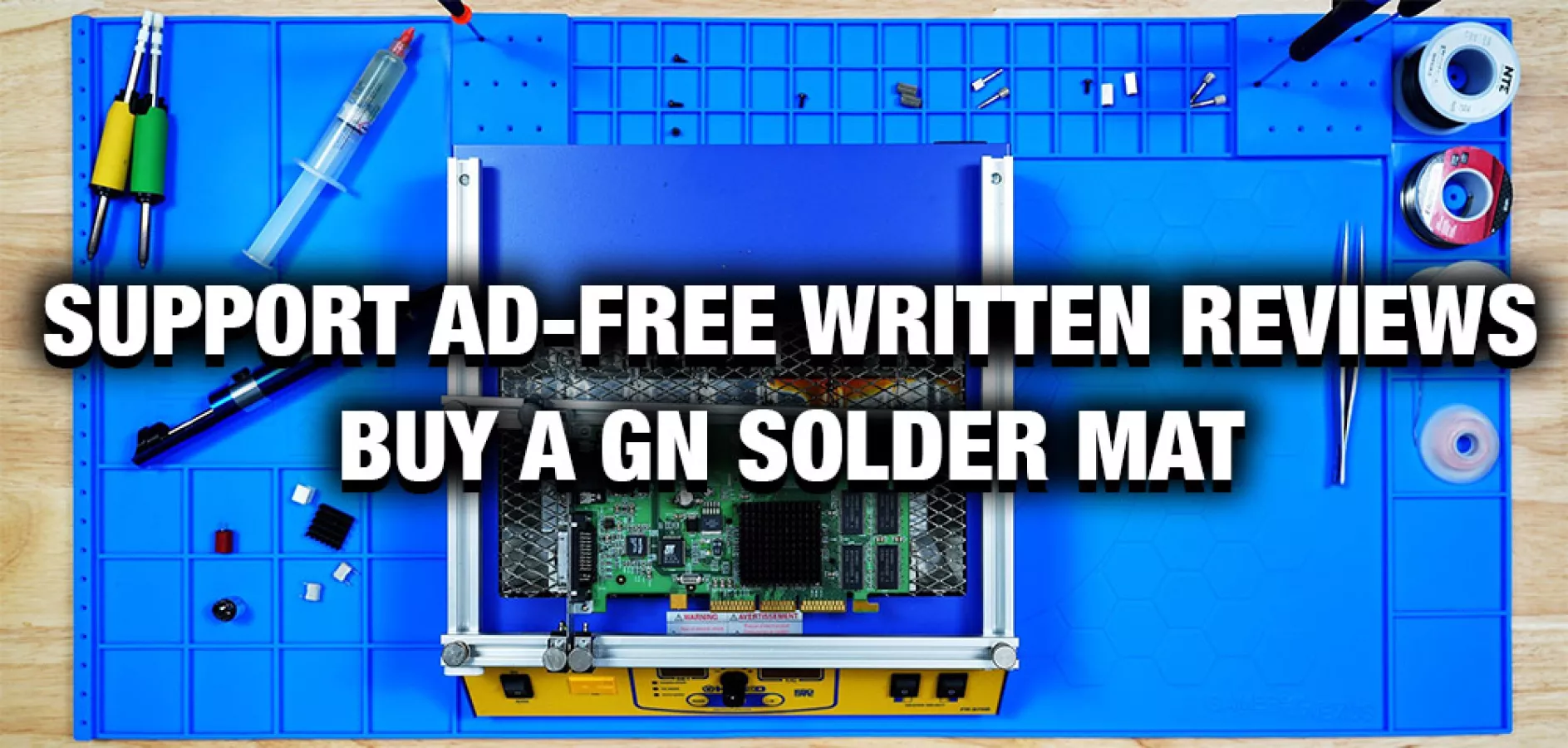
The Voodoo5 6000
The $299 (~$500 adjusted) dual-chip Voodoo5 5500 was the first and only 250nm VSA-100 (Voodoo Scalable Architecture)-based Voodoo5 to market in June of 2000, followed by the budget single-chip Voodoo4 4500 in October.
The Voodoo5 6000 had four GPUs on one card. Some prototype Voodoo5 6000s used a supplementary 4-pin Molex power connector, but the retail product would have had a barrel jack to take power from an external AC "Voodoo Volts" 50W power adapter.
The first thing to note about the card is that it is big. Very big. In fact, it's about a foot long [...]. And it has a price tag to match - the expected US launch price is $600 [...] which begs the question, who on earth would spend that much money on a graphics card?
Eurogamer
3dfx was showing off a prototype Voodoo5 6000 as late as September 2000, with Eurogamer remarking on the obscene size (~12 inches), crazy MSRP ($600, ~$1000 adjusted), and power requirements (60W). We've come a long way to our 500W, $1600, 14” cards.
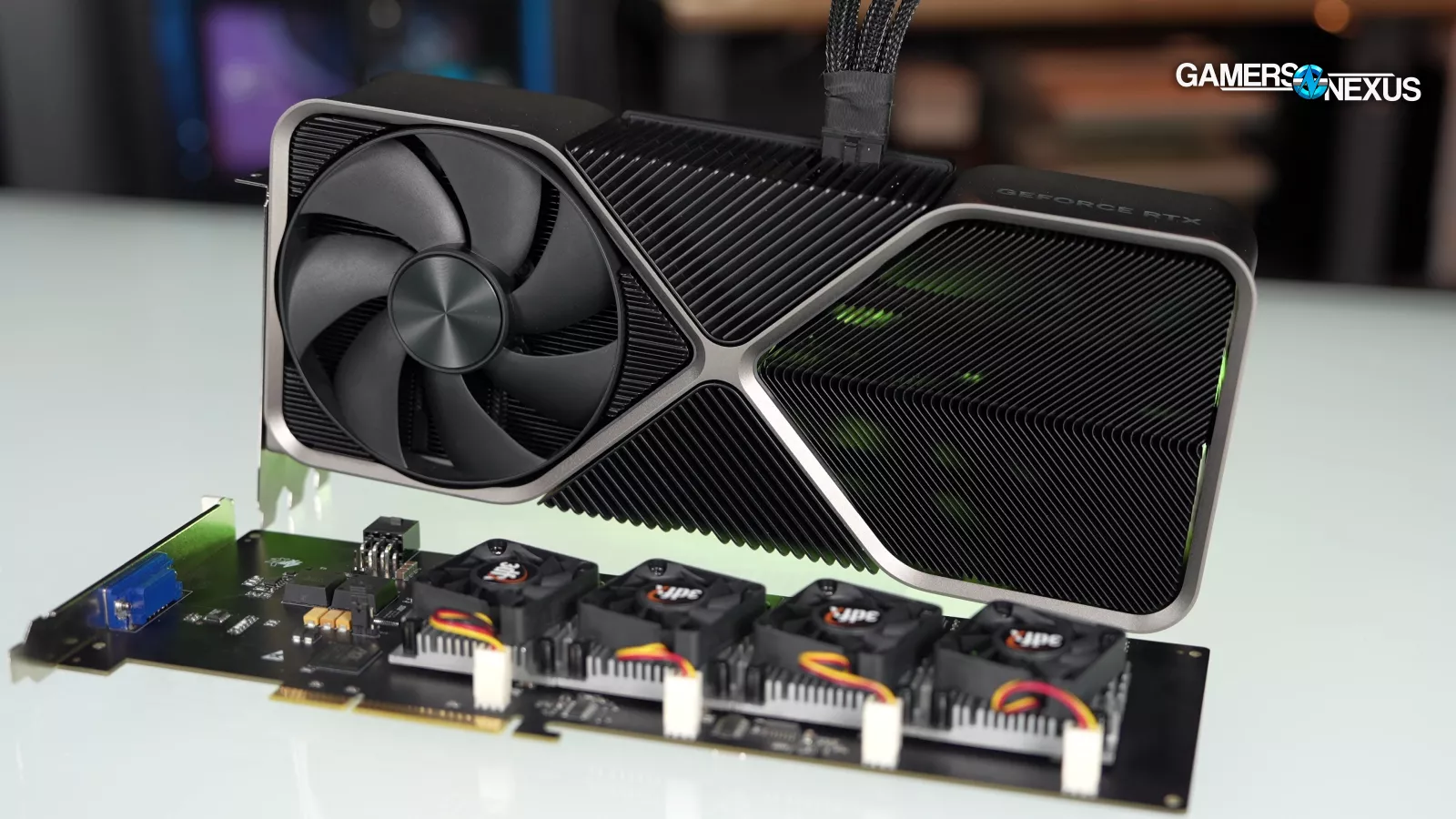
3dfx's Origin
3dfx Interactive was founded in 1994 by former SiliconGraphics Incorporated staff at a point where enterprise 3D had been dominated by SGI for years and PC 3D didn't exist outside of CAD hardware. For more on SGI, check out our Indigo2 Extreme and O2 videos made with the help of SGI Depot.
SGI developed the groundbreaking IrisVision 3D accelerator add-in card for PCs—not just SGI workstations—in 1990, but didn't know what to do with it. Pellucid, a new startup, was spun off with the IrisVision IP. Media Vision Technology bought Pellucid in 1993, then went bust in 1994, with FBI investigations and legal proceedings dragging on for years afterwards. 3dfx was founded by a core group, Scott Sellers, Ross Smith, and Gary Tarolli, that had followed IrisVision from SGI to Media Vision (soon joined by investor/CEO/chairman Gordon Campbell).
3dfx dabbled in some government and arcade sales to start with, but its goal was always the console-dominated home gaming market that SGI had intentionally avoided: SGI believed the market incapable of supporting expensive GPU development. There was some internal debate over whether 3dfx's first boxed product should be an add-in card or a motherboard, but in 1996, 3dfx partnered with Orchid Technology to release the "Righteous 3D" AIC powered by the original Voodoo Graphics 3D chip. 3dfx managed to convince Orchid to sell the 3dfx product without any physical prototype, purely off the strength of prerendering demos on SGI hardware and saying that the final product would look like that.
People would look at it and they'd say 'Well, isn't that what it looks like when you run it on the SiliconGraphics RealityEngine?' and we said 'Yeah!'
Gordon Campbell, 3dfx chairman and original CEO
For that matter, there weren't any existing PC games that could leverage the chips; 3dfx had to develop demos in-house. 3dfx developed its own API as well, Glide, since SGI's OpenGL wasn't initially built for gaming.
The Orchid Righteous 3D is the card that famously made an audible click when the 3D hardware activated and closed relays, enabling the VGA passthrough.
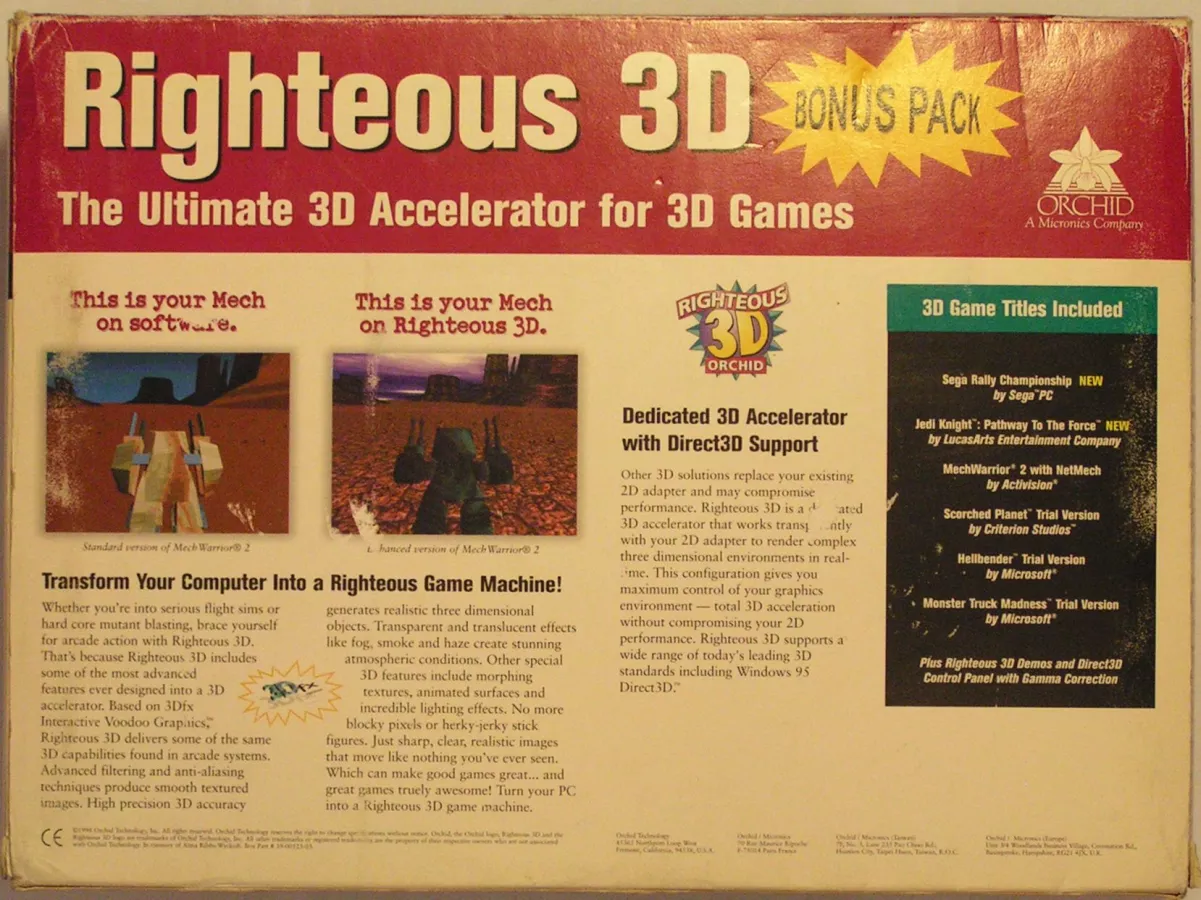
As the box states: "Other 3D solutions replace your existing 2D adapter and may compromise performance. Righteous 3D is a dedicated 3D accelerator that works transparently with your 2D adapter." In other words, it used a VGA passthrough in conjunction with a separate 2D graphics card. This offered a genuine performance advantage over contemporary 3D/2D combo cards, and it also allowed 3dfx to brush past the existing legacy of 2D graphics cards and make something entirely new. The timing was perfect: Windows 95 had just launched, everyone was buying new PCs with PCI slots, and PC gaming was about to become mainstream.
This was a period where software and hardware development were racing forward hand-in-hand: Quake launched in 1996 with software rendering, but in 1997 GLQuake was launched with OpenGL support (which at the time just meant Voodoo support), and John Carmack joined 3dfx's advisory board.
3dfx: The Rise
3dfx was on fire at this time, and it was just getting started. Voodoo cards were must-have hardware for early 3D games like Tomb Raider, especially so for Glide-enabled titles like Unreal and Unreal Tournament.
3dfx had its IPO in 1997. There were some minor stumbles that year, like the ill-fated Voodoo Rush as well as leaking the existence of the Dreamcast and torpedoing a potentially profitable contract with SEGA, but things were still trending upwards. 1998's Voodoo2 and Banshee releases marked the peak of 3dfx's success, with IGN reporting (sourced from PC Data) that the top five GPUs sold in 4Q98 were all Voodoo-based. 73% of "performance/gaming graphics'' market share was held by 3dfx by early 1999. That’s almost exactly like NVIDIA's current position, including the market share percentage, and it's a reminder of just how fickle the graphics market is.
The Voodoo2 was the first consumer card to utilize 3dfx's scalable "scan-line interleave" tech to link multiple cards together (original Voodoo chips had that capability, but it was unused). The abbreviation "SLI" was notoriously later purchased by NVIDIA and backronymed into Scalable Link Interface.
You can't take a high-flying, high-multiple, high-technology, sexy 3D graphics chip company and marry it with a marginal, piece-of-crap board company and come out of it with anything that's good.
Gordon Campbell
Through the release of the Banshee (3dfx's first 2D/3D combo card), 3dfx relied entirely on board partners like Diamond, Creative Labs, and STB Systems, doing zero first-party hardware production. In late 1998, 3dfx's board decided it was ready to live the dream by blowing $141 million (~$243 million in 2022) on major partner STB, based in Texas with manufacturing capability in Mexico.
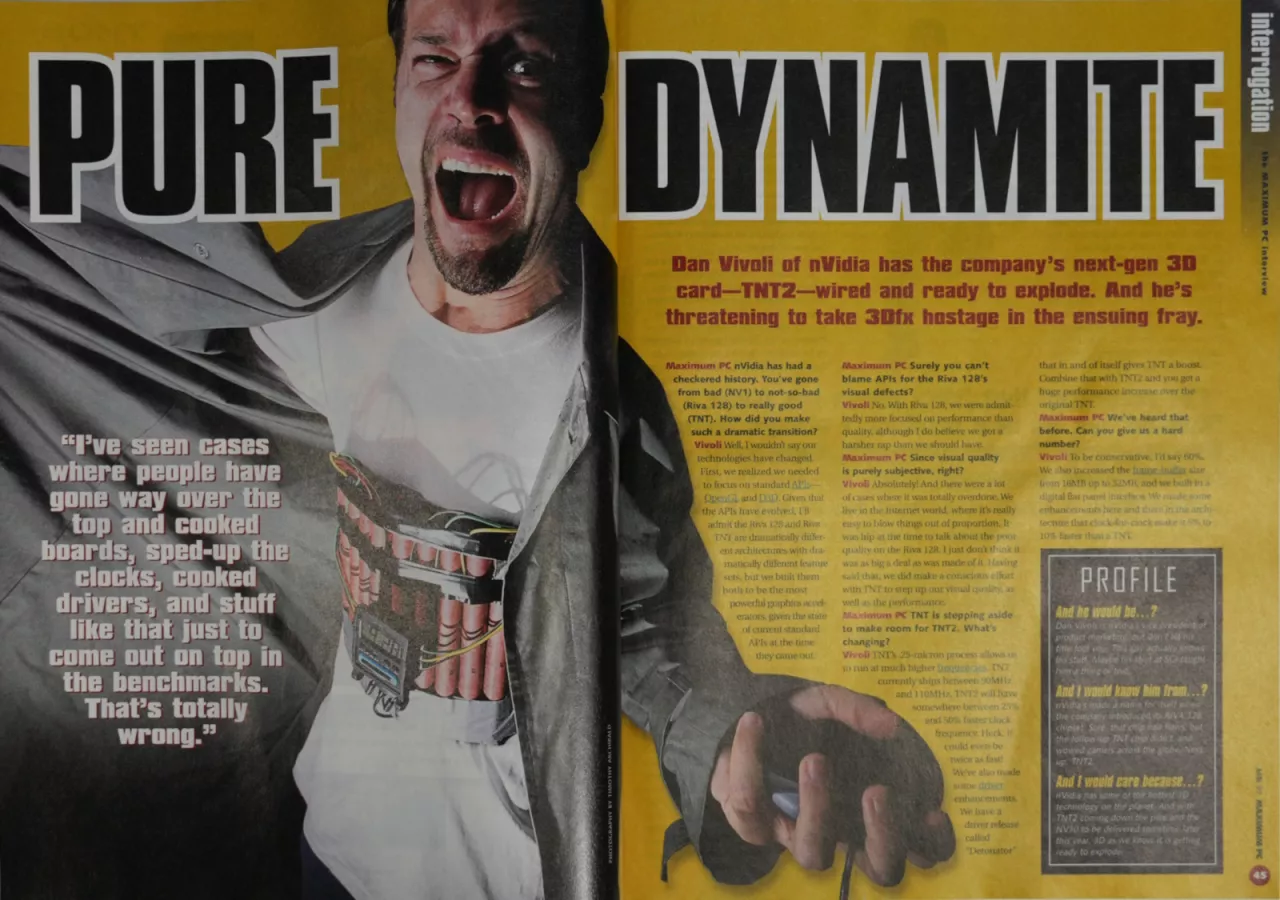
Buying a manufacturer allowed 3dfx to immediately shift from 0% to 100% in-house manufacturing (not including the TSMC-manufactured silicon) and push out its partners, who all promptly turned to the competitor: NVIDIA. If that sounds familiar to you, it did to us, too. It’s amazing how rapidly a “too big to fail” company can instantaneously implode when it treats partners as commodities.
There isn't a person out there that wouldn't mind having a 3D accelerator that would remain at the head of the pack for the next year, instead of finding him/herself wanting an upgrade after about 6 months.
Anand Shimpi, Anandtech
3dfx: The Fall

As the number of competitors scrambling to keep up in an oversaturated market ballooned, 3dfx's designs fell into a rut of recycling old hardware and repeatedly diverting short-term resources away from its next-gen Rampage project, which was delayed past relevance.

DirectX became increasingly dominant in games, and adoption of 3dfx's Glide API was limited. As Anand Shimpi said at the time, "3dfx is back with the third installment in the Voodoo trilogy, but unlike George Lucas' award winning creation, this sequel isn't something to get your hopes too high for." That was written before Episode 1, so maybe don't get your hopes up for The Phantom Menace either, Anand.
3dfx's lead continued to shrink with the launch of NVIDIA's GeForce 2 in May 2000; NVIDIA focused on sales to OEMs, while 3dfx stuck to the relatively small high-end enthusiast market. The wheels fell off rapidly, with 3dfx shuttering STB just two years after its acquisition, then dumping all of its remaining assets on NVIDIA after creditors started bankruptcy proceedings.
The final physical prototypes produced by 3dfx were of the long-delayed and eventually canceled Voodoo5 6000, as well as some number of Spectre 1000 (Rampage) cards which started initial testing days before the company ceased to exist. If you've got a Spectre, email us.
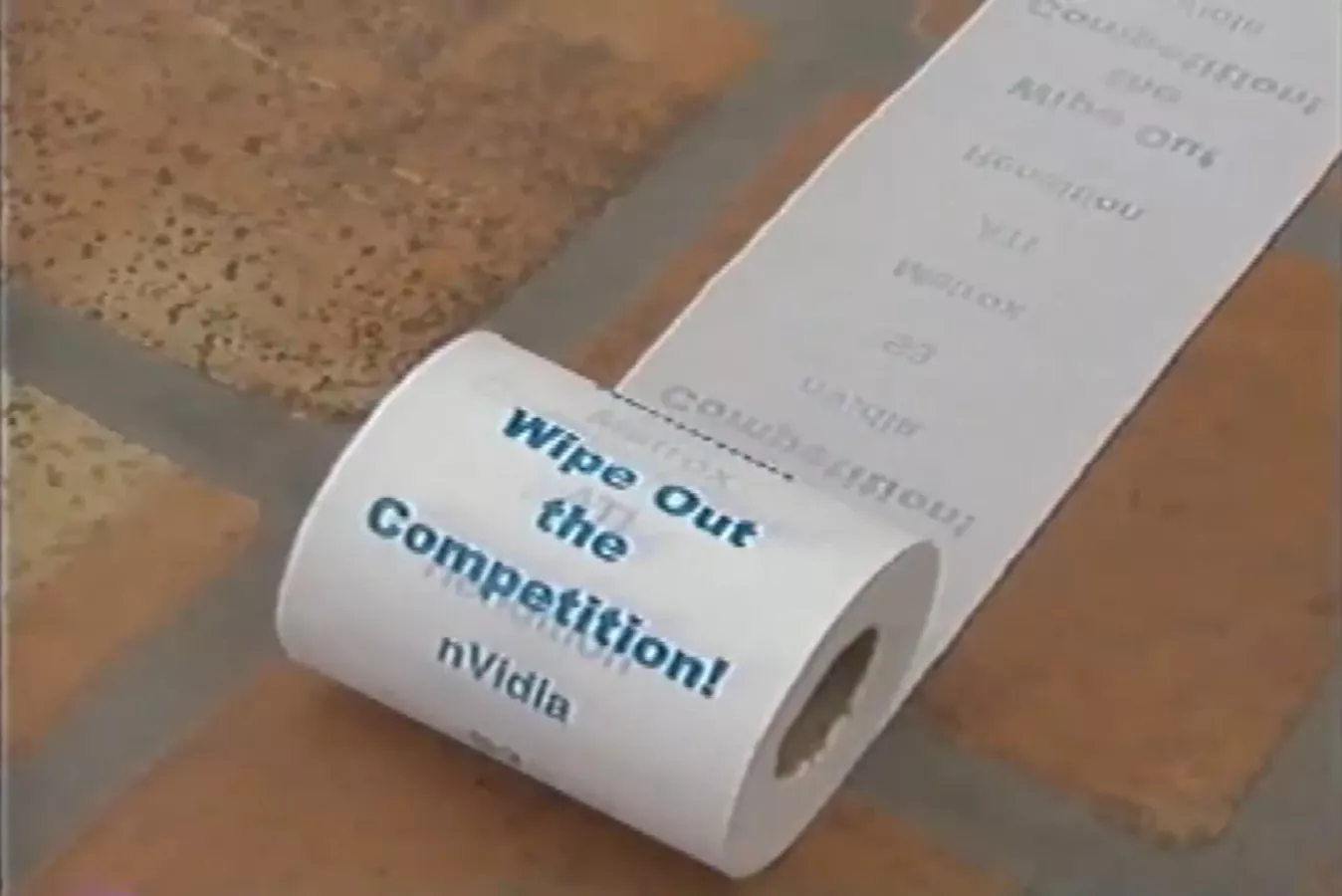
Given the larger-than-life impression that 3dfx made on everyone—we know, we've seen your comments—it's bizarre to think that it only took four years to go from the release of the first Voodoo card to total collapse.
Testing & 3dfx Voodoo Benchmarks
Acquiring Parts
Our original plan was to build a system worthy of ZXC-64's "Snow-White" Voodoo5 6000, with the baseline requirements being a Windows 9x install and an AGP 1.0 compatible slot. After some discussion with Anthony and perusal of old motherboard roundups, we settled on an MSI KT3 Ultra motherboard, which Anand Shimpi himself awarded an Editor's Choice Award. We paired that with an Athlon XP 2600+ Thoroughbred from 2002, from the classic AMD era where "2600+" meant 2133MHz.
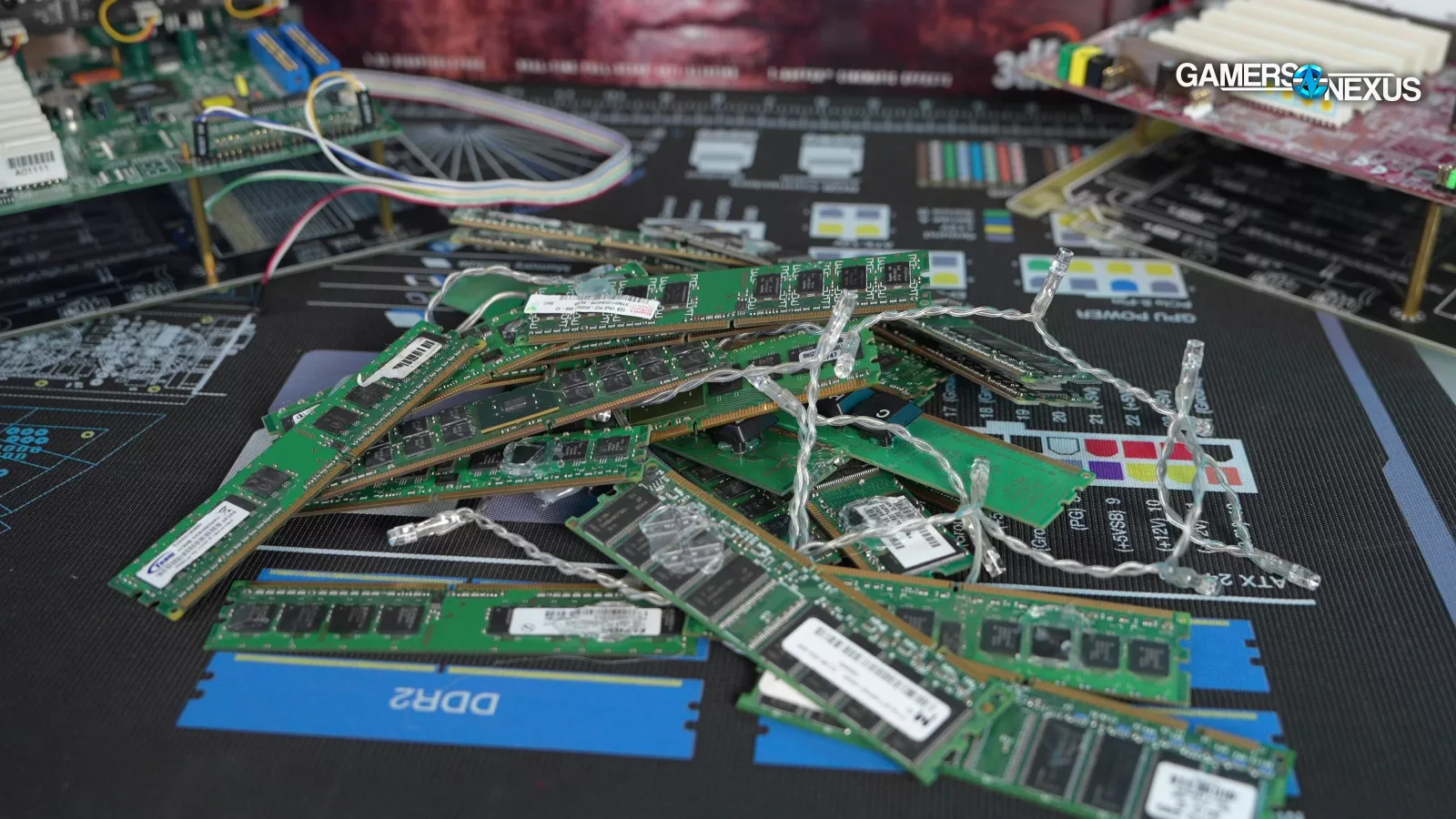
Viewer-donated RAM wreath (RIP) 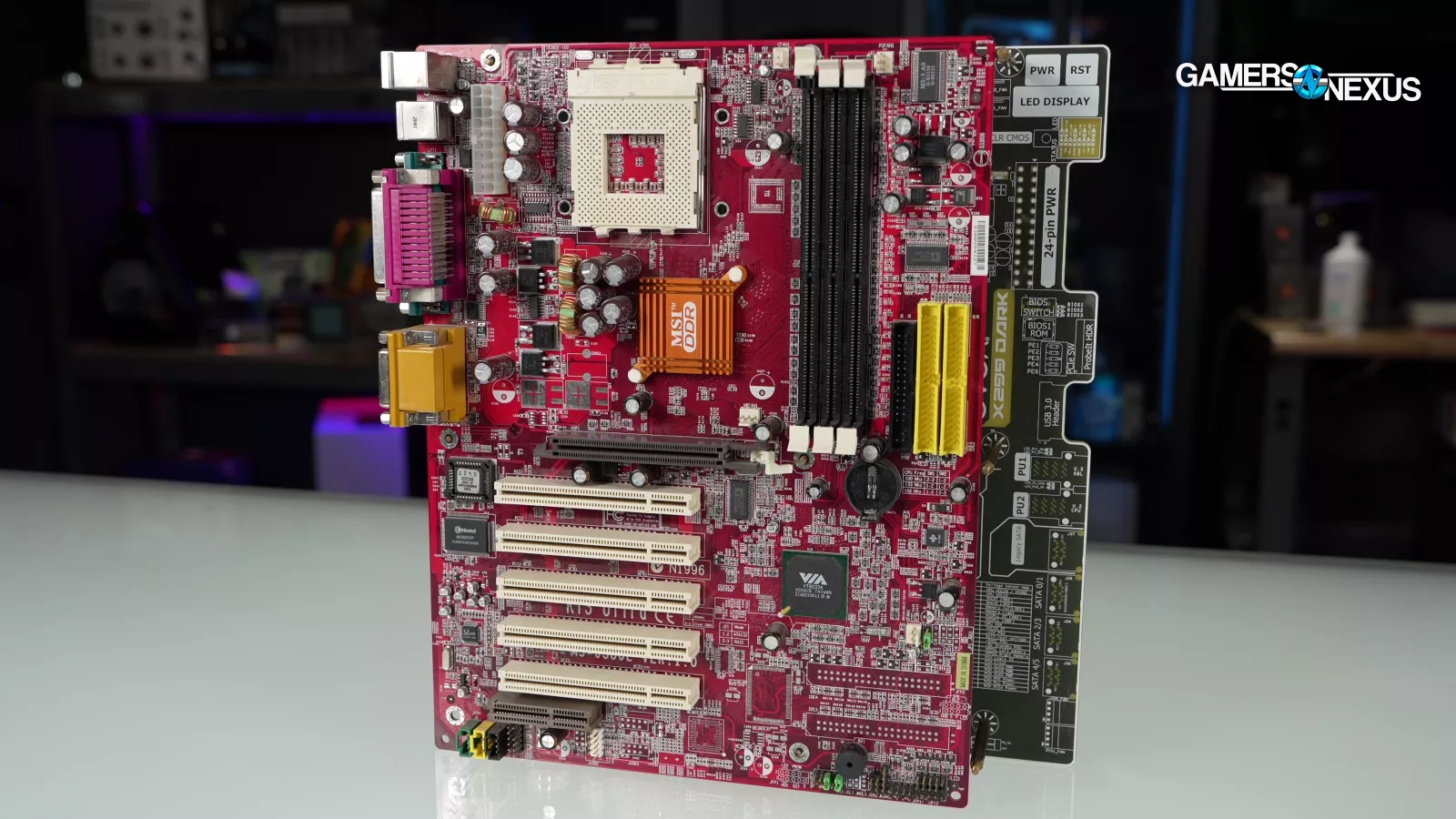
MSI KT3 Ultra 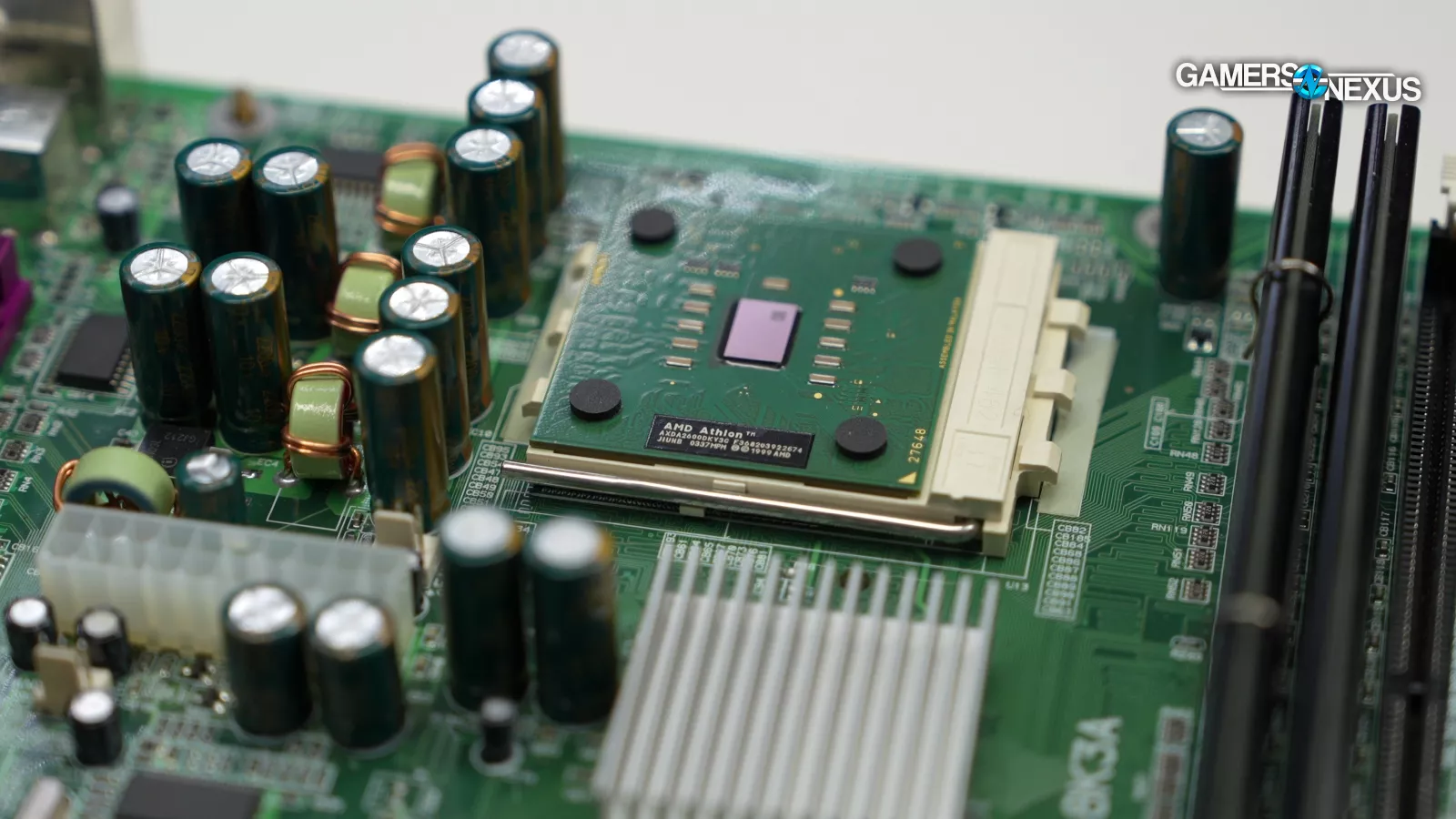
AMD Athlon XP 2600+ 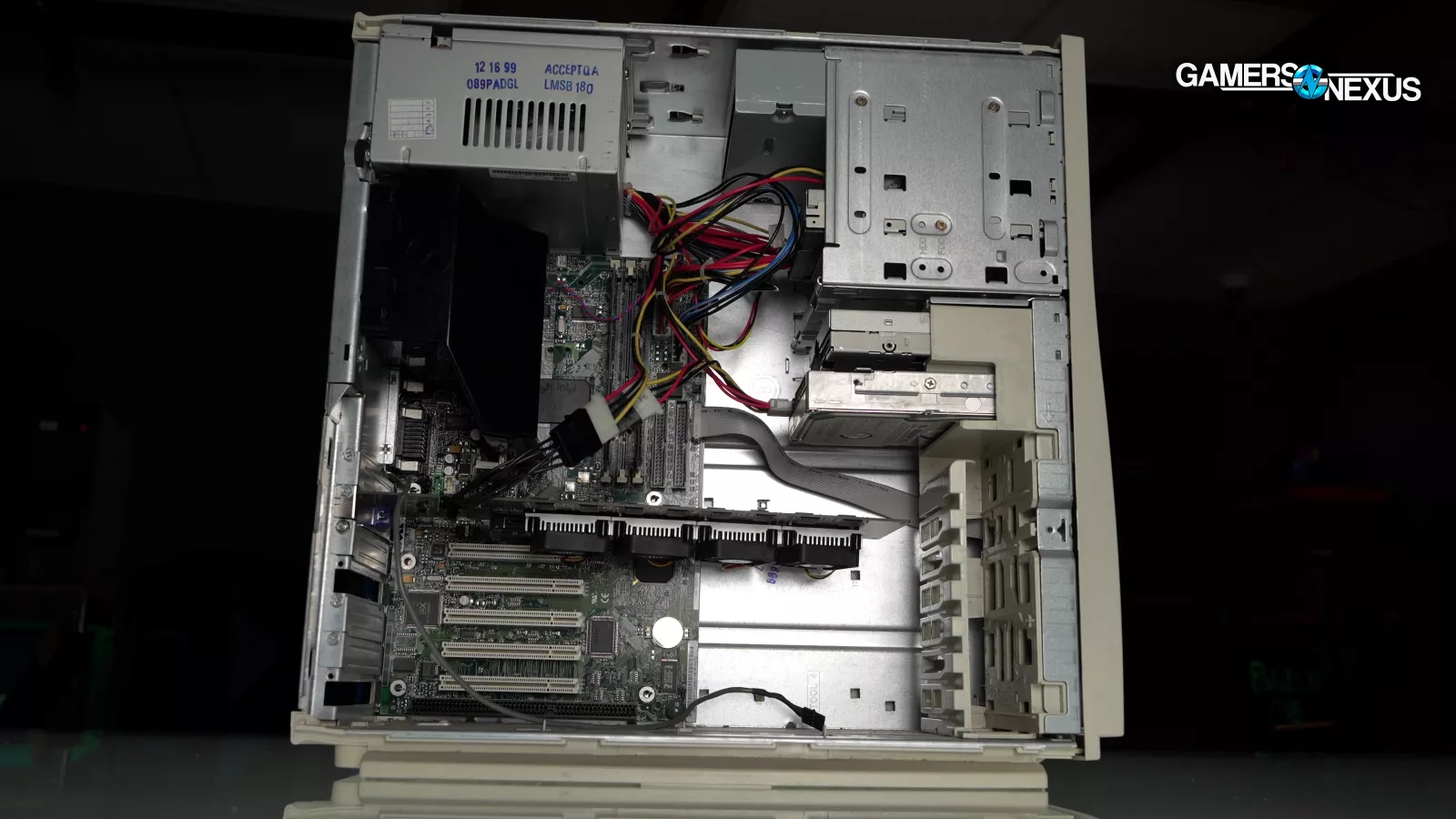
Dell Dimension XPS T600 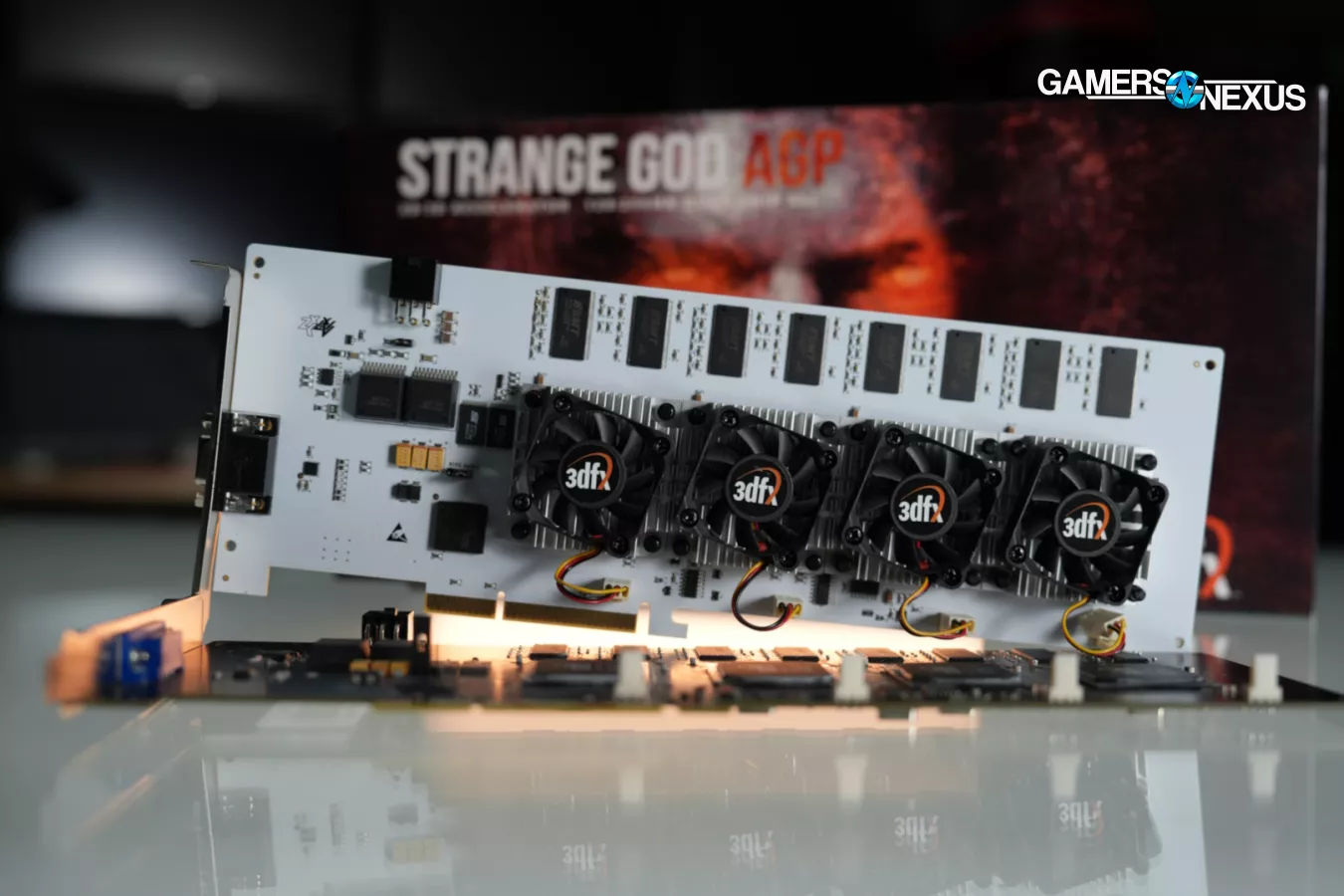
Voodoo5 6000 Snow-White
The motherboard was DOA, but our friends at the Kramden Institute were generous enough to send us an extremely beige 1999-vintage Dell Dimension XPS T600 as backup, and they even waived the $4 scrap price. Out of the box, it came with a 600MHz Pentium III, 128MB of RAM, a Cirrus Logic PCI GPU, a 10/100 NIC, and a 10GB hard drive, all of which was still functional. We upgraded it with a viewer-donated e-waste 800MHz CPU and some memory harvested from a crumbling homemade RAM Christmas wreath.
We confirmed that the Voodoo5 6000 worked with viewer-donated hardware, then bought a new EPoX 8K3A motherboard with a VIA KT333 chipset, reportedly the most stable platform for these tests.
Final Specs
| Category | Component |
| Motherboard | EPoX 8K3A (VIA KT333 chipset, 266MHz FSB) (purchased) |
| CPU | AMD Athlon XP 2600+ (1C/1T, 2.133GHz) (purchased) |
| RAM | Corsair CMX512-3200C2 2x512MB DDR-400 (@333MT/s) (viewer donated) |
| GPU | [Device Under Test] |
| Storage | Seagate DB35 120GB 7200RPM IDE |
| OS | Windows 98 SE (unofficial SP 3.66) |
Running Software
The system was a complete nightmare to get running–we've been working on this piece between reviews for something like three years on-and-off. The sweet spot for compatibility with the Voodoo5 6000 is Windows 9x, so we installed Windows 98 SE with the unofficial Service Pack 3.66 on our test bench. We had constant resource conflict problems on the 8K3A (due to the unusually high amount of VRAM) that we eventually worked around by booting in and out of DOS mode, but the permanent fix was to carefully desolder and move one of the SMDs on the Snow-White in order to reduce the required AGP aperture size. After days (weeks) of troubleshooting, we narrowed down our remaining problems with artifacting and crashes in multi-GPU mode to a defective card, and Anthony swapped us a Strange God AGP so we could complete our testing. In fairness to him, we've seen exactly the same problem reported with retail Voodoo5 5500s, so it looks like his card is a true reproduction—even down to the bugs.
For comparison, we're testing a couple of roughly contemporary AGP cards sent to us by viewers: the 1998 Real3D i740 Starfighter (one of the cards that 3dfx helped to kill) and the 2000 NVIDIA GeForce 2 GTS (one of the cards that helped to kill 3dfx).
Real3D was a spinoff of Lockheed Martin—yes, that Lockheed Martin—that jointly developed the i740 as "Project Auburn" with Intel and CHIPS & Technologies, Inc (coincidentally also co-founded by Gordon Campbell), making this the only consumer Intel dGPU until Arc (other than technically Xe and the elusive i752). And yes, Intel named its debut i740 Starfighter card after the notoriously accident-prone F-104 "widowmaker."
The i740 was meant to champion AGP in opposition to the widespread PCI standard, but as a mediocre budget card it was immediately stomped by the release of the PCI Voodoo2. As Anand Shimpi said in his March 1998 review, "the Voodoo2 remains the king of the 3D world by a considerable margin." Real3D was shuttered in October 1999 and Intel shifted to integrated graphics for the next two decades, with the arguable exception of Larrabee.
The GeForce 2 series would have been NVIDIA's direct competitor to the last generation of Voodoo cards, but with the fall of 3dfx, it was up against ATI's first gen Radeon cards instead. Our GeForce 2 GTS (GigaTexel Shader) is the original 32MB launch model.
This is normally where we'd tell you why our testing is accurate, but in this instance, we're working with cards and hardware that are outside our direct area of expertise (they predate GN by a decade), and we're working with community-developed drivers and an unofficial service pack for Windows 98. We're also testing software that favors Voodoo: this is a fun showcase, not a competitive review. In every test, performance and stability of the card varied based on drivers and whether Anthony's experimental extra VRAM was enabled. We tried drivers from Amigamerlin (2.9), Raziel64 (1.01.16), and the Voodoo5 6000 Resource Group (1.05.04). Overclocking is supported through the 3dfx tools, but we're not going to push our luck on antique hardware. We did one test pass in "Single Chip" mode, utilizing only one of the four VSA-100s and effectively turning the card into a Voodoo4.
Quake III Arena (1999)
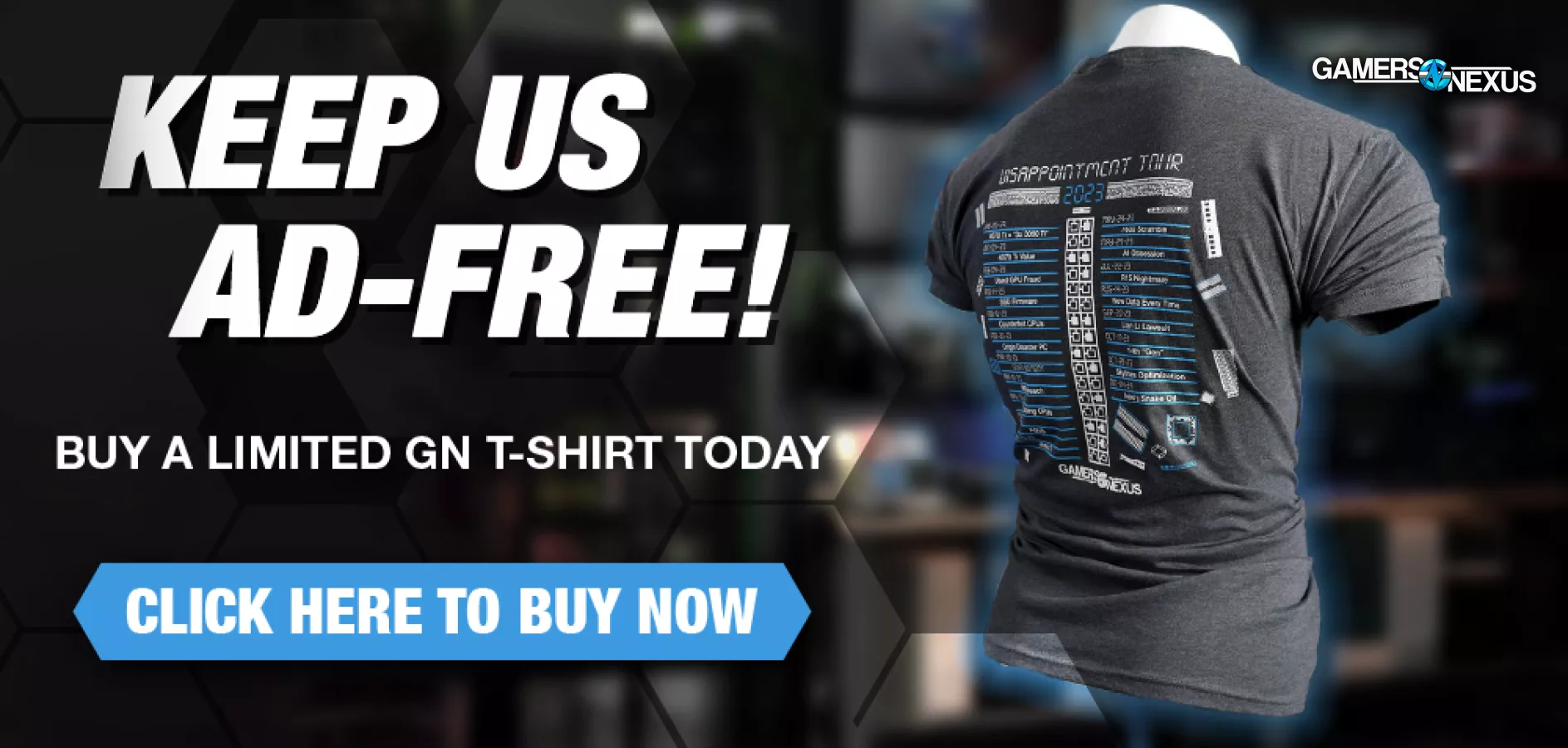
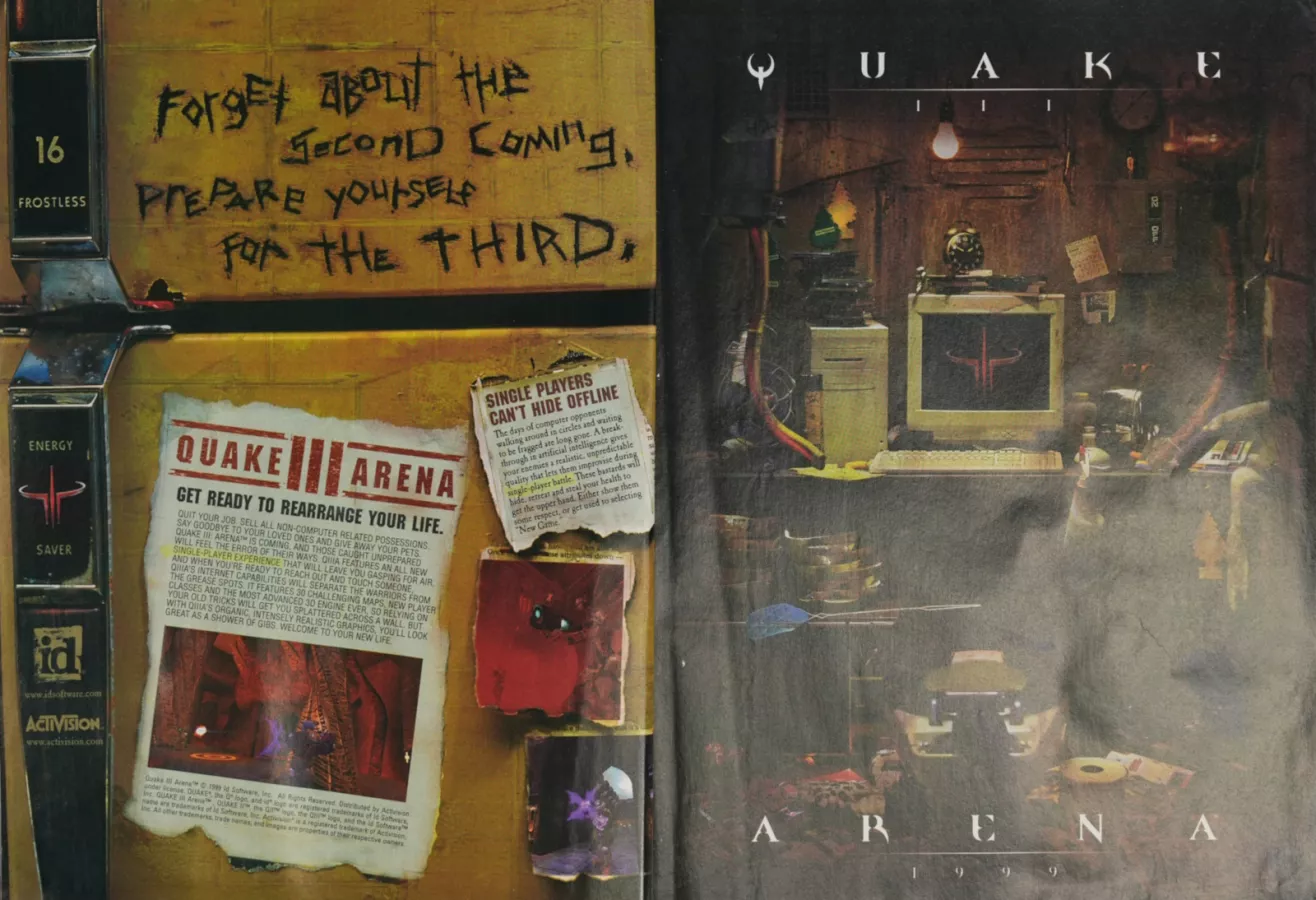
We'll start with Quake III Arena, a game strongly associated with Voodoo. Despite that association, none of the 90s Quake trilogy natively support the Glide API—instead, they use OpenGL with an optional Glide wrapper. As a result, there are a quarter-century's worth of opinions about the best way to run Quake III. We just installed the game, patched it, used the vanilla 3dfxVGL.dll for the Voodoo card, and maxed out the settings. We used id's "FOUR" demo for testing.
| Setting Name | Value |
| GL Driver | Voodoo (on Voodoo card), Default (on other cards) |
| GL Extensions | On |
| Resolution | 1024 x 768 |
| Color Depth | Default |
| Lighting | Lightmap |
| Geometric Detail | High |
| Texture Detail | [Max] |
| Texture Quality | 32 Bit |
| Texture Filter | Trilinear |
| Demo | FOUR.DM_68 (timedemo 1) |
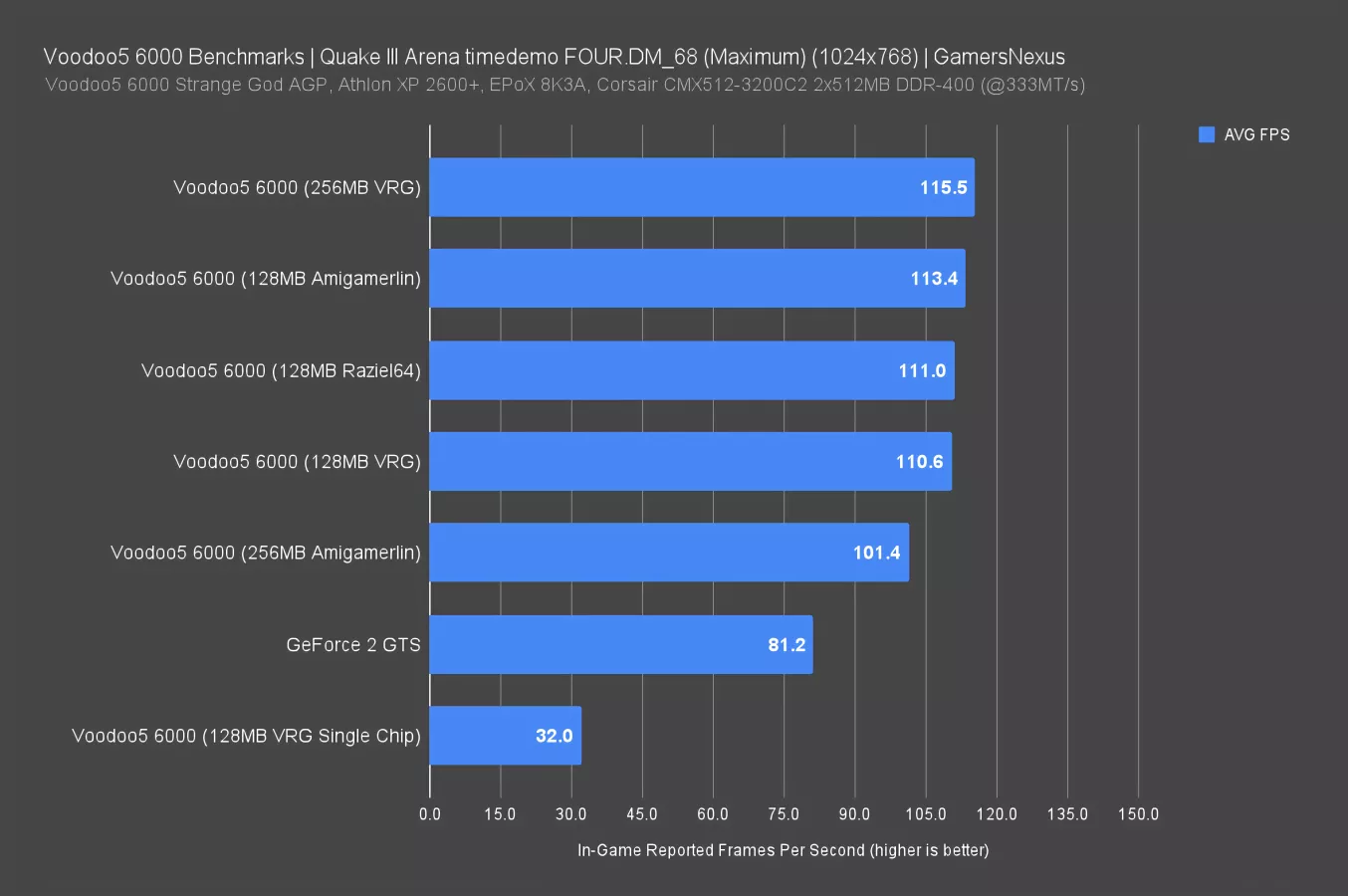
Our best stable result for the Voodoo card was with a driver downloaded from the Voodoo5 6000 Resource Group. There was minor scaling with VRAM on this driver, with a 4% uplift going from 128MB to 256MB mode. Switching to single chip mode massively downgraded performance, which helps illustrate how the GeForce 2 was able to outperform single chip Voodoo4s. NVIDIA's card averaged 81FPS, which is 154% ahead of single chip mode, while the full-performance Voodoo5 6000 outperforms the GeForce 2 in turn by 42%.
We had to switch to Kramden's old Pentium III system to get the i740 to work properly, and even then it couldn't handle rendering the 2D 1280x1024 desktop at 32bpp. Our Starfighter is the 8MB model with no slot for extra memory, which was a feature on some variants. Quake III refused to even launch with the i740 installed.
Unreal Tournament (1999)
Unreal Tournament 1999 was Glide's killer app. Unreal Tournament has true native Glide support, as well as Direct3D for the NVIDIA and Intel cards. Theoretically, we could just slap a NIC in our bench and join a server, but we used the cityintro scene for benchmarking instead, patched up to game version 436.
| Setting Name | Value |
| Video Driver | 3dfx Glide for Windows (for Voodoo), Direct3D (for other cards) |
| Resolution | 1280 x 1024 |
| Color Depth | 16 bit |
| World Texture Detail | High |
| Skin Detail | High |
| Min Desired Framerate | 30 |
| Show Decals | Yes |
| Use Dynamic Lighting | Yes |
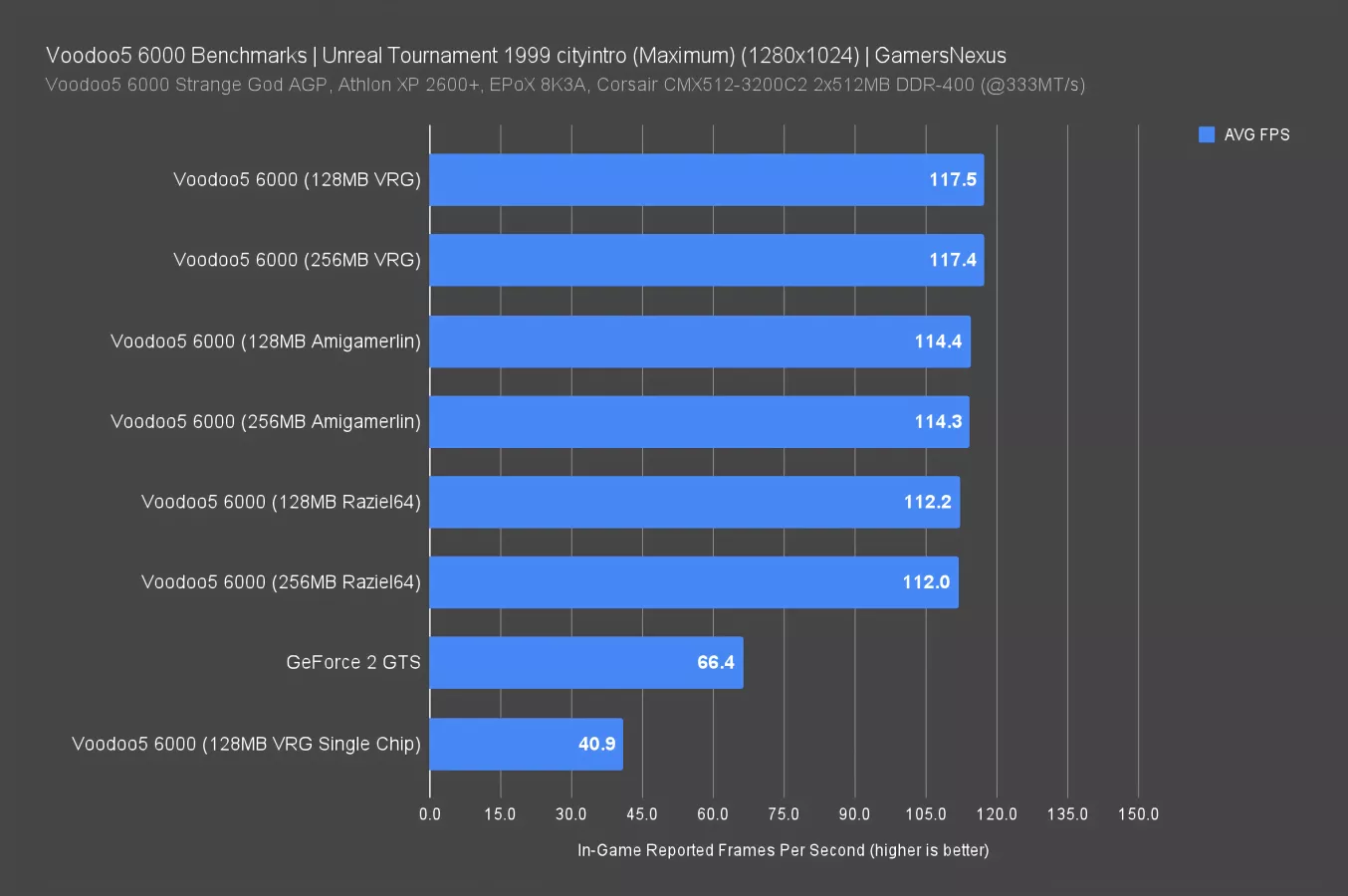
We saw heavy texture artifacting in Unreal Tournament on our Voodoo5, which correlated directly with the texture detail setting. The Raziel64 driver didn't offer the best average framerates, but it did sidestep most of the artifacting issues (while introducing others).
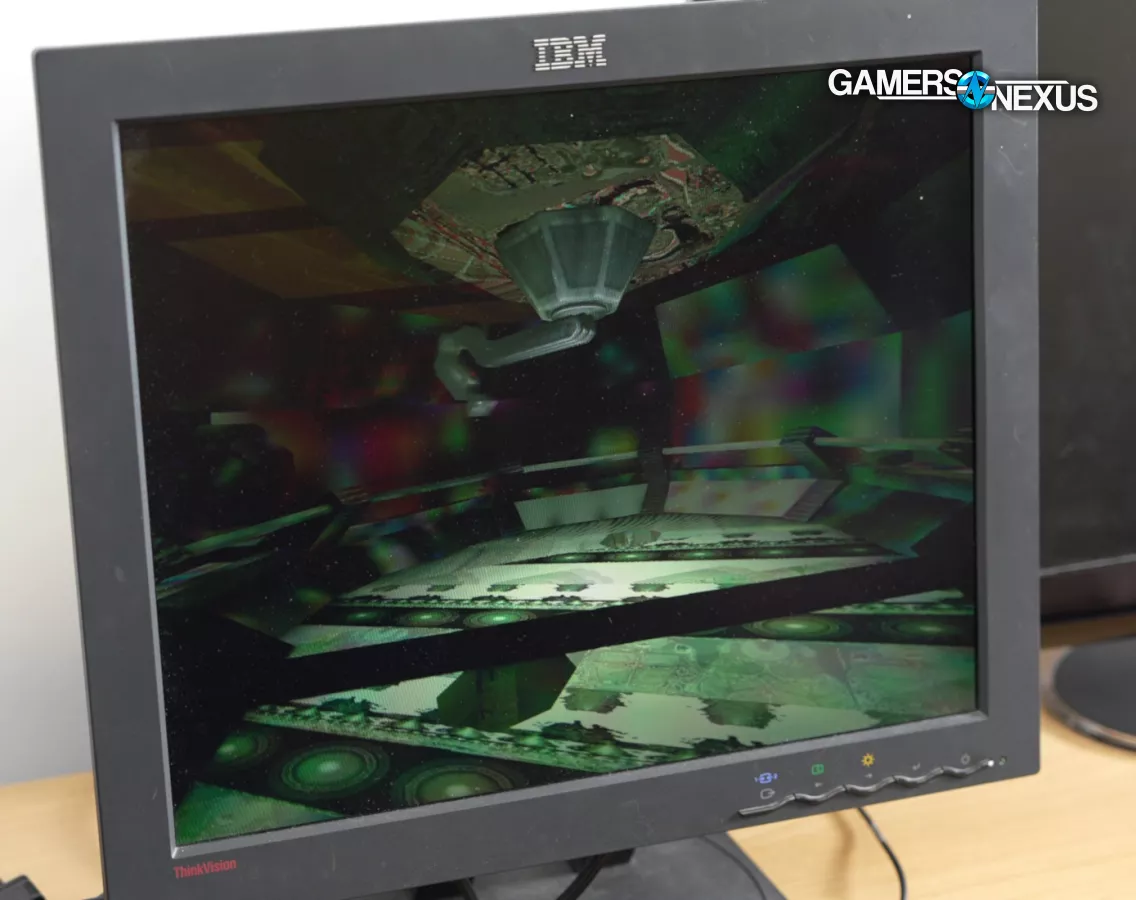
Using the VRG driver, we saw a 62% performance increase from 41FPS single chip Voodoo to 66FPS NVIDIA GeForce 2, a smaller gap than in Quake III. This is 3dfx's home turf. With all four Voodoo GPUs working together, the stable Razeil64 result is 69% ahead of NVIDIA's card, while the artifact-y VRG result is 77% ahead at 117FPS average.
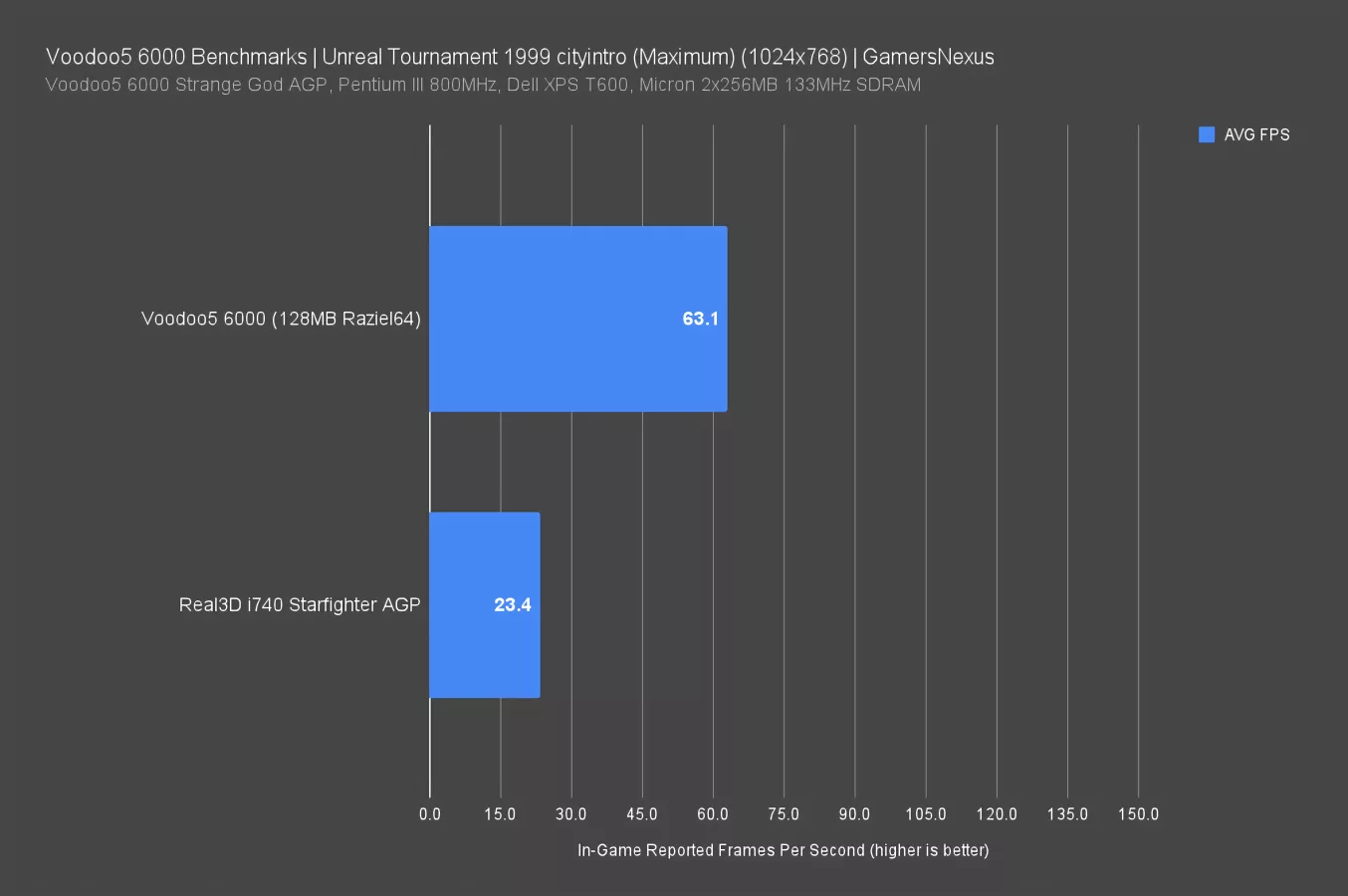
Moving on to 1024x768, the Starfighter did actually manage to run Unreal Tournament -- but only at this resolution. The launcher recommends software (i.e. CPU) rendering for older cards, explicitly mentioning the i740, but we used Direct3D to load the GPU. Intel averaged 23FPS, with the Voodoo5 170% ahead at 63FPS average. The Voodoo card is hugely restricted by the old Pentium III, which is the reason we invested in a new motherboard and CPU. Bottlenecking in benchmarks is just as much a problem with these tests as in modern configurations.
3DMark99 Max
UL hosts free licensed copies of legacy Futuremark suites going all the way back to the original 3DMark99 DirectX 6 benchmark. 3DMark has been a DirectX-only benchmark since its inception, so this test doesn't favor Voodoo as much as the games we selected.
| Setting Name | Value |
| Resolution | 1280 x 1024 |
| Color Depth | 16-bit color |
| Z-Buffer | 16-bit |
| Frame Buffer | Triple buffering |
| Refresh Rate | VSync off |
| CPU Optimization | AMD 3DNow! (on Athlon), Pentium III (on Pentium) |
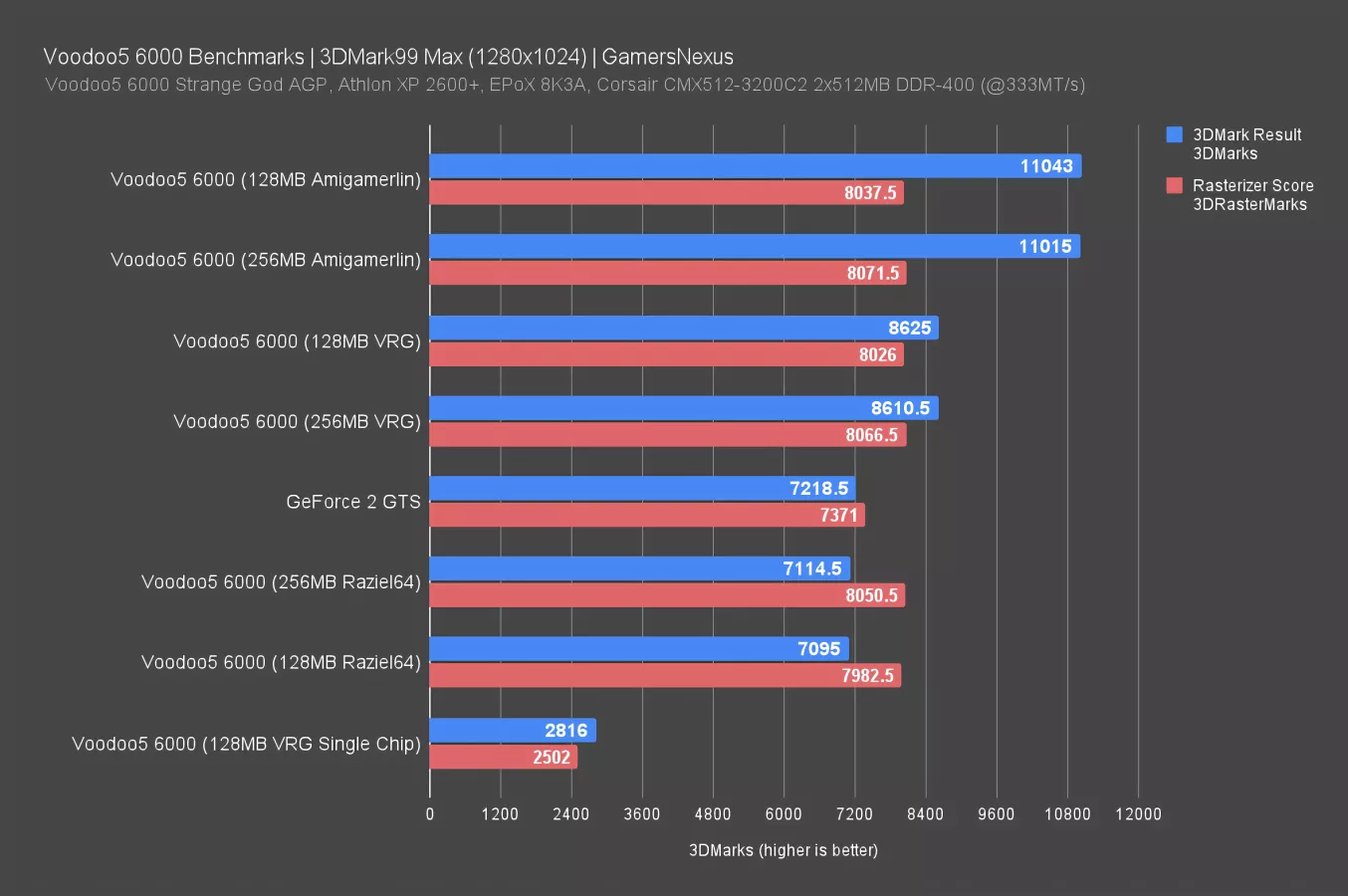
We found the Amigamerlin Voodoo driver offered the best performance, but again, each driver had its own quirks. The trilinear filtering test didn't render correctly on Amigamerlin, while the NVIDIA card had consistent problems with misshapen polygons in the 3D tests.
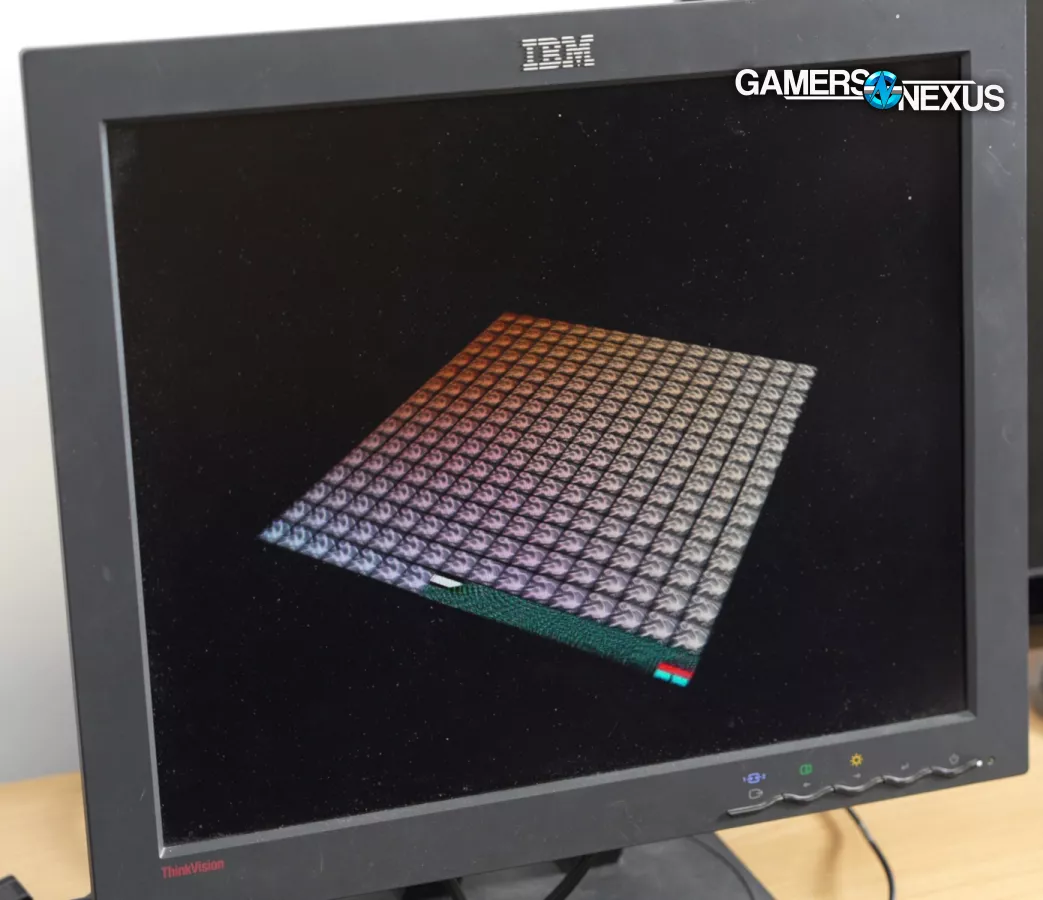
Voodoo 256MB mode texture glitch 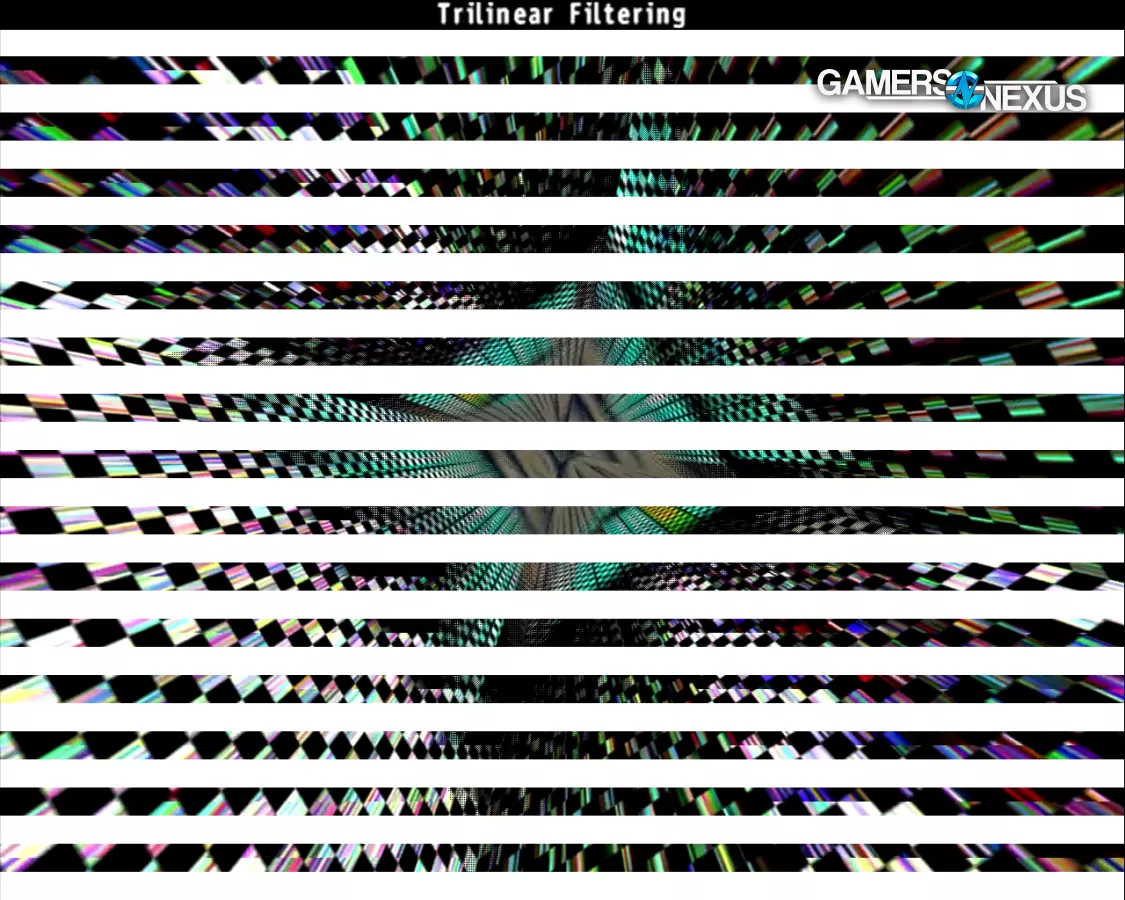
Voodoo Amigamerlin trilinear filtering glitch 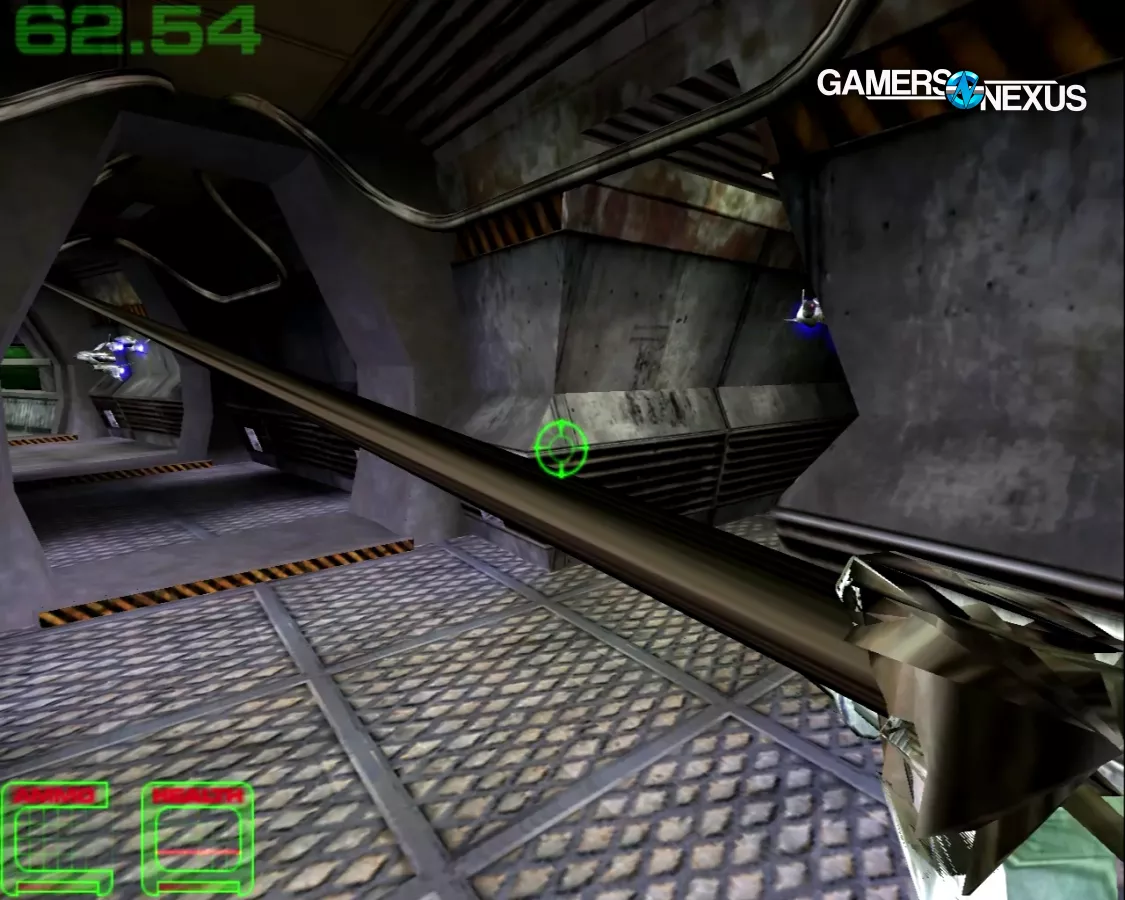
GeForce 2 geometry glitch
This test does provide the best example of Anthony's 256MB memory mode actually helping, as the 32MB texture test ran extremely poorly in 128MB mode. In 256MB mode, though, one edge of the texture consistently showed corruption–we may have a bad memory chip, or it may be a software issue. Amigamerlin 128MB scored 11043 3DMarks, still 53% ahead of the GeForce 2 GTS even in this DirectX application. The GeForce 2's 7219 point average in turn outperformed the single-chip Voodoo by 156%.
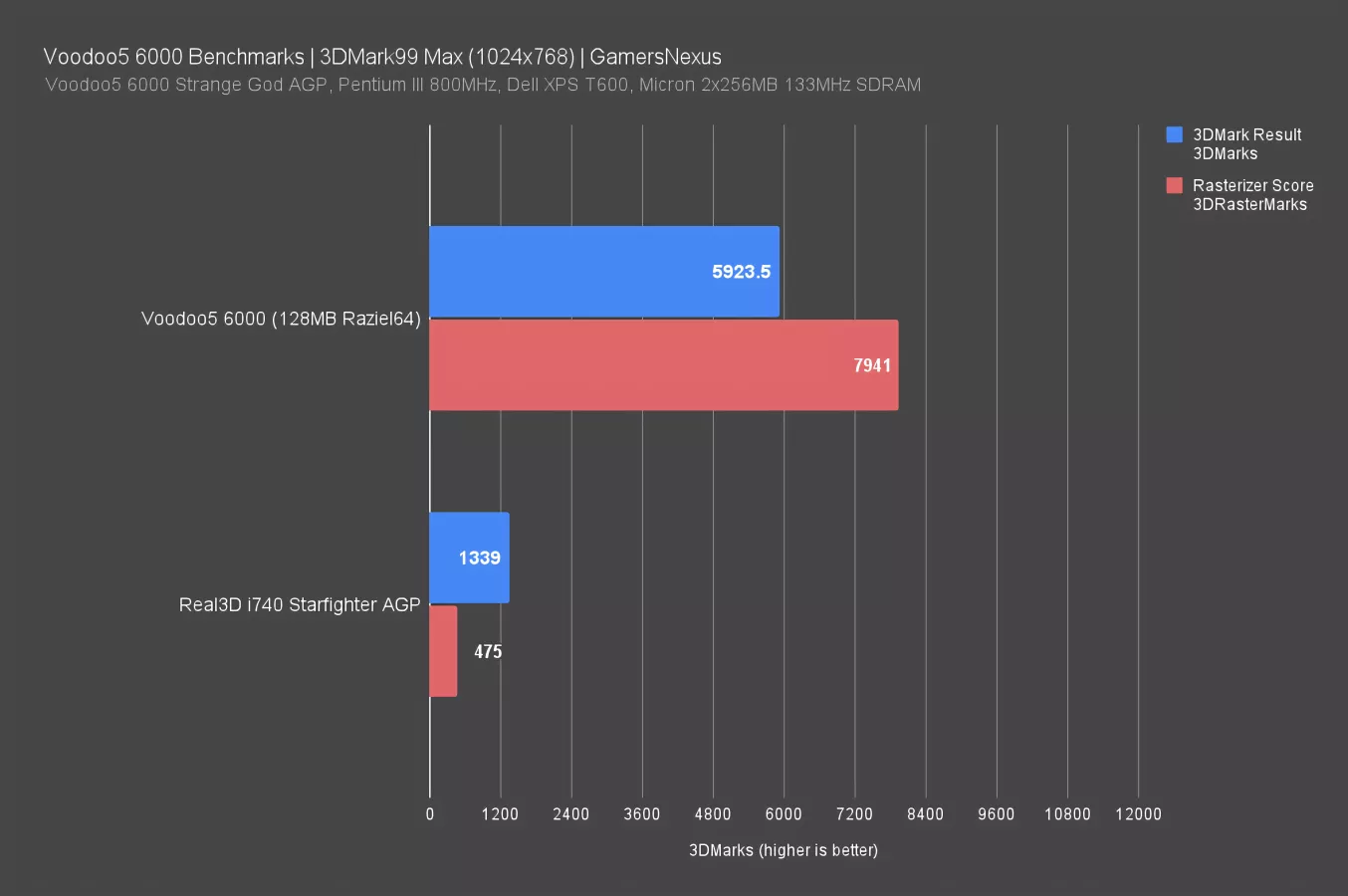
On the older Pentium III platform and at 1024x768, the CPU score is less than a third of what it is with the Athlon, giving us a better picture of the bottleneck. Still, the Voodoo managed a 342% advantage over the i740's overall score at 5924 points versus 1339, with the Voodoo winning in every category except trilinear filtering. The i740 was incapable of running the bump mapping tests, but those aren't factored into the overall score.
Conclusion: The 3dfx Voodoo Replicas

The Voodoo5 6000 couldn't have saved 3dfx, and neither could Rampage. The company was doomed, and one product launch wouldn't have changed anything. NVIDIA's slow-and-steady strategy of building a solid OEM customer base with cheaper, less exciting cards while 3dfx pursued the tiny enthusiast market gave NVIDIA an advantage (although they chase a different market these days), and nearly everyone agrees that 3dfx's fate was sealed the moment it decided to acquire STB. Based on the Computer History Museum's interview, it sounds like "everyone" includes the three co-founders and the chairman (formerly CEO), who were obligated to go along with the board's vote.
If 3dfx had played nice with board partners and moved more quickly on Rampage, it may have been a different story–or it may not have, with the imminent rise of Radeon. This is an example where going where the money is first gave NVIDIA a resource advantage.
Anthony ZXCLXIV can be reached through his Facebook page for purchase inquiries.
